#historiography in middle-earth
Text
Almea is interesting because, despite being fantasy--originally of a very classic mold; it seems to have started out as much of a place for Zompist to set D&D campaigns as anything else--its author is clearly concerned with the mechanics of history: although there is no simple 1:1 comparison (Verduria is not an allegory for France; Ctesifon was not Rome; Xurno is not Russia), the way the world is presented, and the way in which the author explores it, meshes well with the major trends of our own world and how we understand them. Almea is a world you can make historical atlases of; it is a world with its own history of colonialism and international relations and a similar technological arc. It is, in short, a set of fantasy starting conditions (”what if three million years ago aquatic elves and swamp orcs fought an apocalyptic war, and in the aftermath a new hominid civilization tried to re-run Earth history”) whose consequence are worked out in a fairly Earthlike way.
You might contrast this with Middle-Earth--for all that Tolkien had a pretty good head for history and language, he’s much more interested in exploring his fictional history through the framework of legendary narrative. Zompist has the Historical Atlas and the Almeopedia; but Tolkien’s big work is the Silmarillion, a work of history which is primarily concerned with telling that history in the epic mode. You can’t really make a historical atlas of Middle-Earth--for one, it’s not detailed enough. Corners of the world which fall out of the story, like the outer provinces of Arnor after the collapse of the northern kingdom, basically just disappear. There might be something in the big gaps in eastern Rhovanion and Rhun, but it’s clearly not relevant to the stories Tolkien wants to tell, so we have scant sense of what that is.
Comparing different approaches to worldbuilding is interesting to me, because once you start doing that, you really expose how shallow the imagination is of people who think of worldbuilding as, like, a secondary accessory to “real” storytelling. It is a fairly common position that worldbuilding is, I don’t know, basically a second-order activity, an indulgence at best, and that the real purpose of worldbuilding is to provide a good foundation for “proper” stories, which the ends of worldbuilding ought to serve. To me, though, worldbuilding has always been an interesting activity in its own right. Often a much more interesting activity, because how you design a world, the internal and external logic you approach it with, and how you present the results of that design, will not only, as a matter of inevitable consequence, cause certain stories to emerge from that world, in a way that feels as natural as breathing, but will give a strong scaffold, a supporting superstructure that helps those stories fit together in a way that transcends their individual arcs and themes.
For example, all stories that you might tell about Almea are part of an analytic history of a fantasy world that is About what it means to approach a fantasy setting with the tools of modern historiography, political analysis, and sociology, as much as they are About the individual themes of those stories. All stories you might tell about Middle-Earth are About reclaiming the epic mode for modern fantasy, and the possibility of redemption in a world marred by suffering, as they are the Silmarils or the One Ring. Bad worldbuilding often is merely an adjunct to storytelling--and that’s how you get shared settings that feel like a hodgepodge whose elements have no coherent relationship to one another, because the story someone wants to tell comes first, and, well, they’re going to force it to work in the setting whether it’s natural to it or not. And even good writers can build (or contribute to) lousy, boring worlds using this approach.
42 notes
·
View notes
Text
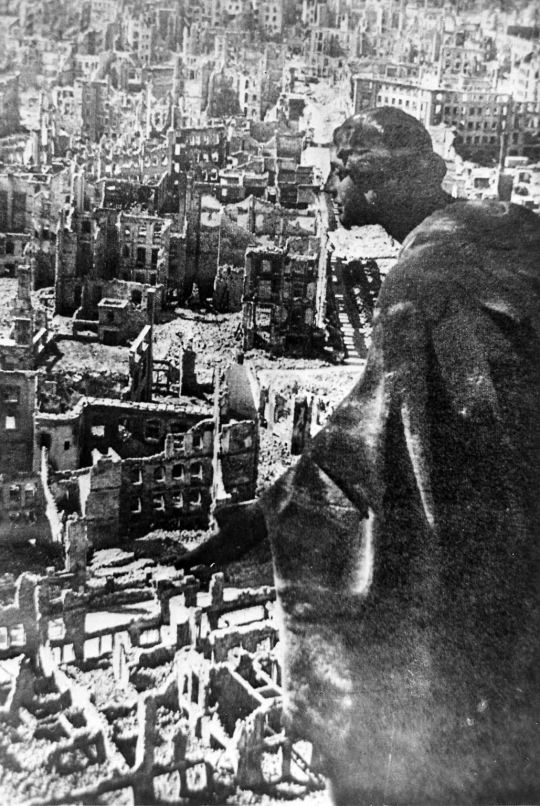








Hell on Earth
Dresden – Cruel Symbol of the West's Destructiveness
From February 13th to 15th, 1945, the Allies flew the worst bombing raids against Dresden. The carpet of bombs dropped over the city created an all-consuming firestorm engulfing the entire center area in a column of destruction and death, sucking everything in. The resulting temperatures were so tremendous that even glass began to melt. People were literally cremated.
Like most Germans, my great-grandmother fled from the advancing Red Army to the inner Reich and was one of the few who survived Dresden. Due to its central location, Dresden was full to the brim with refugees from the eastern German territories at that time. Nonetheless, the Allies deliberately bombarded the city, rather than being confined to the outer industrial complexes. The bombing was aimed exclusively at the civilian population.
The historiography dictated by the Allies speaks of only 25,000 people who died in the bombing. However, Dresden had a population of 630,000 and accommodated many more hundreds of thousands of refugees. Therefore, countless people were drawn in and instantly reduced to ashes by the massive column of fire that developed in the city center, or, if they were below in cellars, boiled like meat in a saucepan into an unrecognizable soup that spilled over the floor. Still, corpses piled up everywhere, for those who were not wiped out by the firestorm suffocated under the burning buildings or died directly in the blasts of falling bombs:

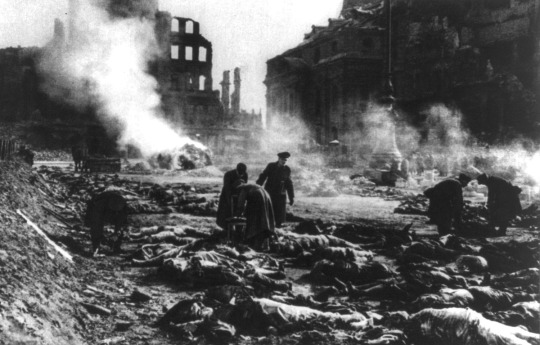


Thousands jumped into the Elbe out of desperation.
Victor Gregg, a British soldier who was a prisoner of war in Dresden at the time, experienced the real hell on earth: "Slowly the horror inside became visible. There were no real complete bodies, only bones and scorched articles of clothing matted together on the floor and stuck together by a sort of jelly substance. There was no flesh visible, what had once been a congregation of people sheltering from the horror above them was now a glutinous mass of solidified fat and bones swimming around, inches thick, on the floor."
Much of the population was literally wiped out, often without leaving anything recognizable of them. Hundreds of thousands died, more than Hiroshima and Nagasaki combined. In April 1945 only about 350,000 people were still living in Dresden, many of whom were refugees from the East who settled all over West and Central Germany, mixed later with the rest of the population. Therefore, most Germans today have ancestors who were expelled. And if I look at the current development, how many more millions of people are fleeing to us because of the American wars, it seems that the German people will continue to be a nation of displaced persons in the future. It disturbs me that these conditions are somehow repeated today, and the same perpetrators are involved.
Deliberate Bomb Terror Against the Civilian Population
In March 1945, Winston Churchill wrote soberly to Royal Air Force Chief of Staff Charles Portal: "It seems to me that the moment has come when the question of bombing German cities simply for the sake of increasing terror, though under other pretexts, should be reviewed. The destruction of Dresden remains a serious query against the conduct of Allied bombing."
What makes this war crime even more unbearable is the fact that Dresden is not an isolated case. The Allies destroyed almost every German city in the same manner.
Luckily, the site where I was born, Wernigerode, is one of the few small towns that were not destroyed by the Allies. Hence, you can still admire the old architecture of the Middle Ages there today. On the other hand, neighboring Halberstadt, which is only 20 kilometers away from Wernigerode, was also completely destroyed in a firestorm. A surviving artist later processed his experience in a painting:

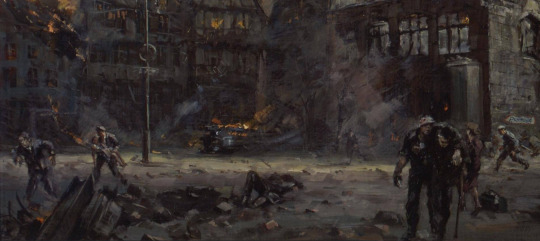
This painting somehow shaped my political views when I looked at it as a youngster. It's mixed feelings of sadness, but also anger, and even hatred, hatred for the US and the West as a whole. Whenever I'm in Halberstadt and the opportunity arises, I have to see it. This picture reflects something inside me, a trauma inherited through my blood.
Magdeburg, the capital of my home state were also entirely bombed out:

Accordingly, I have an extremely allergic reaction when I see how the Allies are bombing Arab countries today. It feels like they're still doing the same thing. I directly feel this pain, this bond with my Arab brothers as a victim of the same perpetrator who does not stop but is looking for other nations to smash for his sphere of influence. Above all, Fallujah in Iraq became another symbol of American terror, where the population is still suffering from the phosphorus bombs and uranium ammunition used.
While we Germans learned from our history and repented for generations, the West continues its wars to this day.
15 notes
·
View notes
Photo
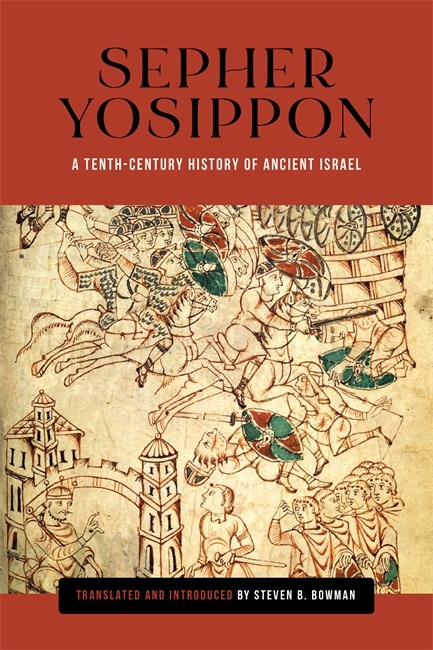
Book Review | Sepher Yosippon: A Tenth-Century History of Ancient Israel, translated by Steven B. Bowman
As the title suggests, this is a new modern English translation of the Sepher Yosippon, the 10th century work of Jewish history which was extremely popular in the medieval and early modern periods. It follows Jewish history from biblical times, when Noah and his sons repopulated the earth after the great flood, to the destruction of the Second Temple and the Battle of Masada. I initially decided to read it after it kept coming up in readings for my Jewish Studies class this past semester. Yosef Hayim Yerushalmi referred to it in Zakhor as the only major historical work written by Jews in the Middle Ages, discussing it in opposition to other ritualized forms of remembrance, such as piyyutim.
Whether or not Sepher Yosippon is entirely unique in terms of medieval history is debatable, but one can see why it holds up to Yerushalmi’s standards of history writing more so than other medieval works. The anonymous author—originally incorrectly assumed to be Josephus, hence the name of the work—was meticulous in his use of historical sources. One particularly interesting thing about his use of sources is that he cites Christian writers as much, if not more, than he cites Jewish ones: two of his main sources are the writings of Jerome and an earlier medieval work called De excidio urbis Hierosolymitae, a Christian polemic which asserted that the destruction of the Second Temple was the Jews’ fault. The author of Sepher Yosippon kept the more neutral historical details from these works, while removing the explicitly antisemitic ones to craft a narrative that was more forgiving to Jews.
Bowman’s translation is based on the critical edition of the Hebrew text published by David Flusser in the 20th century. My Hebrew is not good enough to read the whole text in the original, so I cannot comment on Bowman’s translation in that regard. What I can say is that the text is accompanied by copious translator’s notes, presented in the form of footnotes which explain certain translation choices and note the source texts for various passages. This latter detail I found particularly helpful for my own work in tracing the movement of ideas between medieval Christian and Jewish historians. Overall, I would say that I do recommend this text to anyone interested in medieval historiography. It is a fascinating insight into how Jews were thinking about their own history in the Middle Ages.
14 notes
·
View notes
Text
RINGS OF POWER (aka a FEANORIAN PR TEAM Production)- first 5 minutes
GALADRIEL??!
IS THAT SUPPOSE TO BE FINROD?
ARE SOME OF THOSE FEANORIONS?
WHY ARE THEY USING SINDARIN NAMES? (i'm being picky...but ARTANIS IS SUCH A GOOD NAME)
OMG...talk about white-washing.
....I guess Aqualonde doesn't bear mentioning due to copyright reasons. Or Helcaraxe! Very convenient, Maglor! I know you're still out in the modern world...LINGERING AT THE SHORES OF MIDDLE-EARTH
Then again, this is Galadriel's story. HER role has always been in dispute. This is going to become part of the reason, the historiography of Middle-earth regarding the elves have been and will always be confused. Unreliable narrator.
#i'm full of wretched excitement#rings of power#VALINOR!#tolkien in my entertainment again#things etched in my memory
2 notes
·
View notes
Text
essentially, tldr’ing, this whole thing is me spiraling down one wikihole to another, then trying to check my sources to be sure they're correct, finding out most of them weren't, and proceeding to slip down into even more rabbit holes. this post is literally only half of what ive found. but it took me so long to summarize even a bit of it and it was starting to become a college thesis paper. so i gave up on most of what i was originally going to post and this is the end result! is it a bad idea to be posting this? maybe. am i doing it anyway because ive spent way too much fucking time on this for it not to be shared? yes. yes i am.
.
continuing on from this post, it is officially time for nerding out and posting about information literally nobody asked for!
to save time for anyone who’s curious about the past post, this is everything in it regarding to this subject:
(in regards to the word ‘bel’)
- in Babylonian Mythology Bel is the the god of heaven and earth
- Babylonia, ancient cultural region occupying southeastern Mesopotamia between the Tigris and Euphrates rivers (modern southern Iraq from around Baghdad to the Persian Gulf). the name “Babylon” is derived from the Akkadian word babilu meaning “gate of god,” it is an evident counterfeit of God’s eternal city. The opposition to the rule of God by world powers or the exile of God’s people from the land of blessing is conveyed properly through the metaphor of Babylon.
- the words origin is the Akkadian form of Baal
- Akkadian is an extinct East Semitic language that was spoken in ancient Mesopotamia from the third millennium BC. native to Assyria and Babylon.
now, while falling into one rabbit hole after the other, i realized that this information is not exactly accurate. so im going to try and lay this out in the least confusing way possible. this is going to be long so bear with me here
Babylonia:
Ancient Babylonia left behind some wonderful artifacts. The Babylonians used the innovations of the Sumerians, added to them, and built an empire that gave the world, among other things, codified laws, a tower that soared above the earth, and one of the Seven Wonders of the World. and one of their more impressive and major achievements was the establishment of the world's first written code of law, the Code of Hammurabi.
so there is a lot of history surrounding Babylonia and its reign and state over time. if i really got into it I’d just be basically copy-pasting ten Wikipedia pages. and honestly, that’s pretty useless because you could just read them yourself. that not really the point of this post anyways (watch me now delete half of what I've already written for this).
but i will give a short summary of what I've found:
each source says something else entirely. especially regarding the years. most of the events and the order that they've unfolded are pretty similar, so if you do decide to read up on the place - ignore the time stamps completely.
i do need to make you all aware of the fact that the Babylonian number system uses base 60 instead of 10, and that the base 60 number system is named sexagesimal. Also apparently the system has no zero. i found that entertaining.
so skipping over all the history of the place (shame on me), Geographically, the empire of Babylonia occupied the middle and southern part of Mesopotamia. Situated between the Tigris and Euphrates Rivers, it stretched from the present-day city of Baghdad south to the Persian Gulf.
Babylonian religion:
Babylonians were polytheistic and worshiped a large pantheon of gods and goddesses. Some of the gods were state deities, like Marduk, the chief patron god of Babylon, who dwelled in a towering temple. Others were personal gods that families worshiped at humble home shrines
the Babylonian Chronicles:
The Babylonian Chronicles are a series of tablets recording major events in Babylonian history. They are thus one of the first steps in the development of ancient historiography (the study of how historical recording and interpretations of the same events shift with time as a result of many different factors, basically, the study of historical writing). The Babylonian Chronicles were written in Babylonian cuneiform (logo-syllabic script that was used to write several languages of the Ancient Middle East) by Babylonian astronomers ("Chaldaeans").
from what i could find, the chronicles (at least most of them) are currently at the British Museum.
Assyria:
I'm sot going to go into this empire as much. Because it’s really as important as Babylonia is but mostly because I've been doing this all day and im starting to get annoyed at the inconsistency of my findings.
Assyria was located in the northern part of Mesopotamia, which corresponds to most parts of modern-day Iraq as well as parts of Iran, Kuwait, Syria, and Turkey.
The Assyrians are the indigenous people of northern Iraq, northwestern Iran, southeastern Turkey, and eastern Syria. Today there are over 5 million Assyrians worldwide and they speak the Aramaic language, also known as Syriac. These peoples are also referred to as the Chaldeans, Aramaeans, and Syriacs. Modern Assyrians are the descendants of the ancient Assyrian and Babylonian empires, one of the earliest civilizations emerging in the Middle East, and have a history spanning over 6770 years
the mass migration started in 1975 after the Algerian treaty between Iran and Iraq that enabled Saddam Hussein to destroy many Assyrian and Kurdish villages in the north. Many were executed; hundreds of thousands were forced to leave their lands and resettled in southern Iraq.
Today, Assyrians are one of the most widely scattered indigenous peoples. In Iraq, their fundamental human rights were, and continue to be neglected.
this is a paragraph from an article about todays Assyrians that i found:
the extremely oppressive ideology of Ba'athist regimes in Iraq and Syria denies the very existence of Assyrians as a distinct ethnic group; it tolerates us solely as a Christian subset. In reality, our Christian religion is divided into the Apostolic and Catholic Assyrian Church of the East, Free Assyrian Orthodox Church of Anitoch, Chaldean Catholic Church, and the Protestant Church. Our history is falsified and misused to suit pan-Arabic ideology. We are forbidden to teach our own history or to promote and develop our cultural identity in any way. Particularly, under the dictatorship of Saddam Hussein, Iraq punishes Assyrian national activity with persecution and death. Many Assyrian patriots are either imprisoned or have been murdered. This reign of terror has been well-documented by human rights groups such as Amnesty International and from personal accounts by most of us who left countries, such as Iraq, in search of refuge and civilized order in Europe, Australia, and America.
i myself haven't done a lot of research into this topic so im not going to pretend that i do. this post is supposed to be a lighthearted “jesus christ i’ve fallen into so many rabbit holes by just trying to figure out a name for my Beetlejuice fanfic”. though now that i find myself on this specific slide, i once again am hit with how history is actually a thing and these things that happened thousands of years ago are still affecting so many people today.
i’m going to leave this in here because this is something important that needs to be talked about, i had no idea about this before today and i doubt many other people do either. so please, if you’re reading this and from what you know this information is false, dm me privately and let me know without causing a scene.
OK BACK TO OUR REGULARLY SCHEDULED LIGHT HEARTED TOPICS
Akkadian:
Akkadian is an extinct East Semitic language that was spoken in ancient Mesopotamia from the third millennium BC until its gradual replacement by Akkadian-influenced Old Aramaic among Mesopotamians by the 8th century BC. It is the earliest documented Semitic language. it was written in a cuneiform script. As the Akkad dynasty proliferated, Akkadian replaced Sumerian, the world’s oldest-known written language, as the spoken tongue of southern Mesopotamia. Simultaneously, Akkadian splintered off into Babylonian and Assyrian dialects, with Babylonian becoming the lingua franca of the Middle East around the ninth century B.C.
so what does the word bel actually mean?
in mythology Bêl (/ˈbeɪl/; from Akkadian: bēlu) is a title signifying "lord" or "master" applied to various gods in the Mesopotamian religion of Akkad, Assyria, and Babylonia.
Bel was especially used for the Babylonian god Marduk. basically, bel was a title meaning lord, so like how the Christians call their god “the lord”, if someone back then only said the word bel, it could be understood that they were referring to the lord of the gods.
there is though an actual god named Bel. He was the chief-god (the supreme deity) of Palmyra, Syria in pre-Hellenistic times, being worshipped alongside the gods Aglibol (the moon god) and Yarhibol (god of nature maybe?). they weren't the only gods in the pantheon, the three just almost always showed up together. The Temple of Bel in Palmrya, Syria was dedicated to this god, it has since been destroyed by ISIS
why is bel defined as the god of the earth in Babylonian and Assyrian mythology if they're different religions?
from what i understand, Assyria and Babylonia can be thought of like siblings. always fighting to be the best and one up each other. Assyria and Babylonia were both created out of the ashes of the Akkadian empire. so im guessing that’s why they’re also almost always put together in regards to their gods. The ancient Assyrians and Babylonians did believe in mostly the same gods, had a similar culture and customs, and even spoke the same languages
yet while the Babylonians believed in a Supreme God, the Assyrians based their religion around the concept of animism, the attribution of a life force to inanimate objects. Assyrians formed a military dynasty whereas Babylonians became merchants and agriculturalists and the supreme ruler in Assyria was an autocratic king while in Babylonia, priesthood was the highest authority.
anyways, please don't come for me if any of this is wrong, feel free too add to it if you want to. my work here is finally complete
#its shitpost hour but instead of shitposts its nerdpost#i spent actual fucking hours on this#and yet i cant spend ten minutes on something i actually have to do#babylonia#babylon#assyria#assyrians#history#A.B.L Foundation
0 notes
Link
[I posted this essay to my blog The Heretic Loremaster over the weekend. Click the link above if you’d rather read it there. Reactions are welcome in both places.]
Who wrote The Silmarillion? It's a question with a more complicated answer than it seems on the surface. Yes, of course, J.R.R. Tolkien wrote the book that I picked up from a Barnes & Noble fourteen years ago, that is now on my desk with its cover coming off and its corners rounded from being read so many times. But who, in the vast imagined world within its pages, is telling the story? The narrator of The Silmarillion is so distant as to be barely discernible at all; it is possible to believe he doesn't exist at all. Indeed, in at least my first two readings, I did not think much of him. I assumed a distant, omniscient presence recounting what happened in plain, incontestable terms. Just the facts, ma'am.
The fact is, though, that J.R.R. Tolkien--the Silmarillion author whose name is on the cover--always imagined and constructed his stories not just as stories but as historiography: documents written by someone within the universe in which the history occurs. This complicates things: gone is the distance, the omniscience, and perhaps most importantly, the impression that the stories happened exactly as they are told.
This wouldn't be a problem--in fact, would be quite simple, as most fiction has point of view that is biased or unreliable--but for the fact that this isn't simple: This is Tolkien. So naturally, he had this idea that he wanted to write his stories as historiography, with a loremaster or chronicler who was himself a part of that history, but he couldn't make up his mind who this person was. In fact, he changed his mind several times, reversals that are documented in The History of Middle-earth for fans and scholars to angst and argue over.
I'm going to make the case that the "Quenta Silmarillion" is part of the Elvish tradition. This is contrary to the belief of Christopher Tolkien and other Tolkien scholars, who assign it to the "Mannish"--namely Númenórean--tradition. (@ingwiel has an excellent discussion of the evidence for this approach.) I understand why they did this, but I think that if you look deeply at the texts and the evidence those texts provide, there is not much to support that the tradition originated with the Númenóreans. (I am willing to concede that Elvish texts may have passed through Númenórean hands on their way back to Elrond and, eventually, Bilbo, but I persist in believing they are nonetheless predominantly Elvish texts representing an Elvish point of view.)
The Idea of the "Mannish" Tradition
The Elvish loremaster Pengolodh was first introduced as the primary author of the "Quenta Silmarillion" prior to 1930, when he was assigned author of the Annals of Beleriand (HoMe IV). Pengolodh was a tenacious character: Texts written as late as 1960 were still being assigned to him. So what happened?
The idea of the "Mannish" loremaster was a late idea and introduced as part of the series of writings collected by Christopher Tolkien under the title Myths Transformed (HoMe X). In a text that Christopher dates to 1958, Tolkien writes:
It is now clear to me that in any case the Mythology must actually be a 'Mannish' affair. ... The High Eldar living and being tutored by the demiurgic beings must have known, or at least their writers and loremasters must have known, the 'truth' (according to their measure of understanding). What we have in the Silmarillion etc. are traditions (especially personalized, and centred upon actors, such as Fëanor) handed on by Men in Númenor and later in Middle-earth (Arnor and Gondor); but already far back--from the first association of the Dúnedain and Elf-friends with the Eldar in Beleriand--blended and confused with their own Mannish myths and cosmic ideas. (Myths Transformed, "Text I," emphasis in the original)
To summarize: in 1958, Tolkien began to deeply question whether a civilization as advanced as that of the Eldar--a civilization that also had access to the teachings of the Ainur, who knew firsthand the structure of the universe--would produce myths that included such components as a flat Earth and the "astronomically absurd business of the making of the Sun and Moon" ("Text I"). This led to some radical cosmological rearrangements in Myths Transformed--and the relatively overlooked decision to reimagine the Silmarillion histories from a Mortal rather than an Elvish perspective. In an undated text also presented in Myths Transformed, Tolkien again takes up this question and explains the method of textual transmission in greater detail:
It has to be remembered that the 'mythology' is represented as being two stages removed from a true record: it is based first upon Elvish records and lore about the Valar and their own dealings with them; and these have reached us (fragmentarily) only through relics of Númenórean (human) traditions, derived from the Eldar, in the earlier parts, though for later times supplemented by anthropocentric histories and tales. These, it is true, came down through the 'Faithful' and their descendants in Middle-earth, but could not altogether escape the darkening of the picture due to the hostility of the rebellious Númenóreans to the Valar. ("Text VII")
"A leading consideration in the preparation of the text was the achievement of coherence and consistency," Christopher Tolkien wrote in a note on The Valaquenta in The Later Quenta Silmarillion II (HoMe X), "and a fundamental problem was uncertainty as to the mode by which in my father's later thought the 'Lore of the Eldar' had been transmitted."
Christopher Tolkien tentatively dates The Later Quenta Silmarillion II (LQ2) to 1958. Along with the last set of annals, The Annals of Aman and The Grey Annals, this represents the final version of the Silmarillion that his father produced. (See "Note on Dating" at the end of LQ2 in HoMe X.) Interesting about these texts--especially LQ2--is the fact that Tolkien removes all attributions Pengolodh. Mentions of Pengolodh are sprinkled throughout the Later Quenta Silmarillion I, which was written around 1951-52. When Tolkien "remoulded" LQ1 into LQ2, he removed Pengolodh. Also written around 1958? That first Myths Transformed text in which Tolkien asserts that his cosmology requires a Mortal and specifically bars an Eldarin loremaster.
And the Evidence of the Elvish, Part 1: The Creative Process
All this probably seems very simple. Tolkien was clear on his intentions. The Elvish tradition doesn't work, in his opinion. Therefore, it must be Mortal. He even took out the Elvish loremaster from the oldest Silmarillion draft. Simple, right?
Never. Working with any of the Silmarillion material--including the published Silmarillion--is necessarily speculative. This is a posthumous text, unfinished and existing in many forms. I think Christopher Tolkien did an admirable job of making a published book out of the tangle of his father's writings, but making that book required making decisions, as alluded to above, about how to decide what to include.
On this particular question, there are two approaches to making a decision on mode of transmission: There is Tolkien's stated intention, and there are the texts themselves and what they show of the realization of that intention. Christopher Tolkien, and many scholars, clearly prefer the first approach. Tolkien was clear on what he wanted, so that's the way to read the texts.
I prefer the second.
Perhaps this is because I approach the welter of Silmarillion texts as a creative writer as well as a Tolkien scholar. My experiences as an author of fiction myself lead me to question whether the creative process lends itself to the kind of neat analysis that says, "The author stated his intention. Here we have our answer." My experience tells me it is rarely that simple.
Below is what I imagine the creative process looks like for worldbuilding and constructing stories in that world, done in clipart and scribbles. For me, most of my work goes on in my mind: while driving to work, falling asleep at night, reading other authors' work, washing dishes, daydreaming. Some of the thinking is intentional, other occurs because it's where my mind wanders where I'm bored. Sometimes, thinking is sparked by an outside stimulus: an interview on the radio, a song, an image, a clip from a movie or TV. All of it goes into this tangle of thought constantly swirling in my mind, making and remaking my imagined world. Every now and then, an idea leaves my mind and takes concrete form as I write it down.

But only in limited instances do these ideas become finalized, incontrovertible--"canon," if you will. Sometimes an idea won't work and withers, unfinished. Other times, an idea is written down, only to dive back into the welter of thought in my mind for further reworking and reshaping--sometimes radically so.
Every author's creative process is different, of course, but hold up The Tale of the Sun and the Moon from the Book of Lost Tales next to the story Tolkien writes in Myths Transformed and the two are radically different, showing what any Silmarillion fan can tell you: Just because Tolkien wrote it down doesn't mean he meant it. Likewise, he went years at times without working on the legendarium, yet his letters and the progress we observe in the drafts show that he was always thinking about it. In short, his creative process, in this regard, seems a lot like mine.
Around 1958, we can say with some certainty that an idea crystallized from Tolkien's thoughts about his legendarium that the mode of transmission had to be centered on Mortals, not Elves. The idea seems to have loomed large in his awareness--along with ancillary ideas about cosmology--to the extent that it appears to reflect in decisions he made in revising LQ2.
But does that mean it is definitive? That it is "canon"? Not necessarily. In fact, I'd argue that we have proof that this particular manifestation of an idea was one that was far from finalized but dove back into the swirl of thinking on worldbuilding to be reconsidered and reworked--and ultimately unrealized.
And the Evidence of the Elvish, Part 2: Point of View
Point of view is no small thing in a story. In fact, in all but a few cases, it is so essential that to change the point of view risks breaking the story in a way that changing other elements rarely does. It's like painting. If you paint from the point of view of a peasant looking at a castle from the field where she labors, you cannot suddenly decide that the point of view is that of the princess looking out from the room in the castle where she spends most of her days, at least without redoing the painting entirely.
Likewise, one cannot take a story written from one point of view, then suddenly decide to change to a different point of view with any guarantee that the story will still work, much less make sense, without rewriting the story. In fact, in many cases, it will not.
Changing from an Elvish to a Númenórean point of view is not so simple as declaring, "Let it be!" and there it is. In the case of the "Quenta Silmarillion," the Eldarin (specifically Gondolindrim) perspective is deeply embedded. @grundyscribbling‘s post here is a good run-down of how the narrator's affiliation with Gondolin is revealed, even if never stated, in the stories included as part of the "Quenta." My article Attainable Vistas looks at some of the numerical data I've compiled that suggests a Gondolindrim perspective. At last year's Tolkien at UVM Conference, I presented more of that data, as well as new evidence that even the narrator's language in the "Quenta," reveals the point of view of a loremaster from Gondolin. Tolkien didn't put Pengolodh's biography down on paper until the 1959-60 text Quendi and Eldar, but the texts suggest that Pengolodh's identity was swirling in his mind many decades before that, and he wrote the "Quenta" with that point of view always in mind. Changing the point of view of such a story requires significant rewriting of the text. Do we have evidence that any of that rewriting--short of striking Pengolodh's name from LQ2--occurred?
No, we do not.
In fact, we sometimes see the opposite.
And the Evidence of the Elvish, Part 3: The Texts
The Later Quenta Silmarillion II becomes a relevant text to examine here because 1) it was written at the time when we know Tolkien was thinking about the mode of transmission and 2) his striking of Pengolodh's name from this version suggests he was beginning to act on his stated intention to revise the "Quenta" to reflect a Númenórean point of view. It is also an interesting text to study because it is a revision of LQ1, written about seven years earlier when the mode of transmission was, as far as I can tell, unreservedly Elvish.
Does the LQ2 contain other revisions toward a Númenórean mode? No, it is does not. In fact, it includes additions that, from a Mortal perspective, are suspect.
Laws and Customs among the Eldar. One of two major additions to LQ2 was Laws and Customs among the Eldar (L&C). L&C is explicitly attributed to Ælfwine, the Mortal man who was part of the mode of the transmission involving Pengolodh. Ælfwine is Anglo-Saxon, not Númenórean, but L&C is clearly written from the point of view of a Mortal commenting on Elves.
L&C opens with the sentence, "The Eldar grew in bodily form slower than Men, but in mind more swiftly." This comparison immediately establishes a Mortal point of view different from that of the "Quenta" as a whole, where Mortals are usually but supporting actors in a drama enacted by Elves. The first two paragraphs continue this comparison and assume the distinct point of view of a Mortal. Later, in the section "Of Naming," the narrator notes that the variety of names used by a single Elf "in the reading of their histories may to us seem bewildering," again establishing a Mortal point of view (emphasis mine).
L&C is an example of what a text written from a Mortal point of view would look like. "Men are really only interested in Men and in Men's ideas and visions," Tolkien wrote in Myths Transformed, and L&C acknowledges this by bringing Elvish customs into the context of Mortal experience ("Text I"). This text shows that Tolkien did manipulate the point of view based on his narrator. (This won't be shocking to any writer of fiction, and as an Anglo-Saxonist, Tolkien would have been aware of the impact of point of view on a historical text from that perspective as well.)
Christopher Tolkien dates L&C to the late 1950s (LQ2, "Note on Dating"). The argument could be made that Tolkien hadn't yet begun the process of revising to incorporate a Númenórean narrator. However, of all of the texts in LQ2, L&C is the easiest to revise to change the point of view. It is already from a Mortal point of view! Simply change the attribution to Ælfwine to a suitably Númenórean name and you have a major chapter of LQ2 aligned with the Númenórean mode of transmission. It is a surface change on the order of removing attributions to Pengolodh, and the fact that Tolkien didn't undertake it makes me question how seriously he truly undertook to revise the point of view.
The Statute of Finwë and Míriel. The Statute of Finwë and Míriel is the second major addition to LQ2. It is likewise dated to the late 1950s (LQ2, "Note on Dating"). If Tolkien wanted to write a text representing a Númenórean point of view, he couldn't have done a worse job of it with the Statute of Finwë and Míriel. Here we have a text deeply concerned with eschatology: Elven eschatology.
The Númenóreans were also concerned with eschatology. You could even say the Númenóreans were obsessed with eschatology, and immortality in particular. Here's a people, after all, annihilated because of their king's obsession with an Oasis song proclaiming, "You and I are gonna live forever!" A Númenórean text that represents Elven eschatology with no commentary grounding it in a Mortal perspective (like Tolkien does with L&C) is almost impossible to fathom. A text that centers on immortality and the decision to forgo immortality would certainly excite commentary from a Númenórean loremaster. Revisions to represent a Númenórean point of view would have to address this chapter--but they don't. Again, this suggests that JRRT's ideas about the mode of transmission weren't as definitive as his writings in Myths Transformed suggest.
And all the rest ...? Outside of L&C, the remainder of LQ2 includes nothing that suggests a Mortal point of view, even though L&C shows that Tolkien was capable, with the addition of a few words, of beginning to establish this. A convincing Númenórean text would have needed deep revisions, but surface changes--like the deletion of Pengolodh--set the course in the right direction.
Throughout the "Quenta," Tolkien often uses formulas like "it is said," "it is told," and "it is sung" to indicate that the narrator is receiving information secondhand versus as an eyewitness account. As I discussed at the Tolkien at UVM Conference in 2017, these formulas are used primarily with the Ainur and Mortals. The image below shows the data from one of my slides from this presentation. Adding these formulas is a rather easy way to signal that the information the narrator is reporting is at a distance from him--and LQ2 uses them when reporting on the actions of Ainur to which even an Eldarin narrator could not have borne witness--yet Tolkien did not make these revisions. Instead, this part of the Silmarillion (originally attributed to Rúmil, who would have been present for this history) is written in the style of an eyewitness account, even though a Númenórean loremaster would certainly find these chapters of history the most distant and unattainable. Yet nothing in the style in which these chapters are written suggest this.
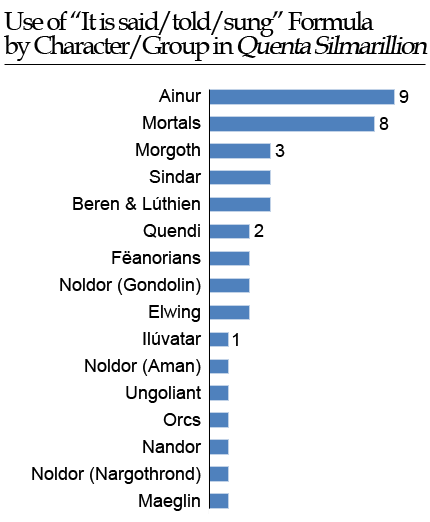
There is one passage in particular in the chapter "Of the Silmarils and the Unrest of the Noldor" that, like the Statute of Finwë and Míriel, seems a ripe opportunity to make revisions to signal a Mortal narrator if Tolkien desired to do so:
In those days, moreover, though the Valar knew indeed of the coming of Men that were to be, the Elves as yet knew naught of it ... but now a whisper went among the Elves that Manwë held them captive so that Men might come and supplant them in the dominions of Middle-earth. For the Valar saw that this weaker and short-lived race would be easily swayed by them. Alas! little have the Valar ever prevailed to sway the wills of Men; but many of the Noldor believed, or half-believed, these evil words. (emphasis mine)
It is hard to imagine a Mortal loremaster self-identifying as "weaker and short-lived" or offering up such an assessment without commentary. Yet this passage was brought over from LQ1--when the narrator was Elvish--without revision.
Another small passage again betrays the Elvish perspective: "But now the deeds of Fëanor could not be passed over, and the Valar were wroth; and dismayed also, perceiving that more was at work than the wilfulness of youth" ("Of the Silmarils," emphasis mine). According to the timelines in the Annals of Aman, Fëanor was about three hundred years old at this point. For a Mortal narrator--even a long-lived Númenórean one--to describe him as a "youth" is difficult to fathom.
Now one might claim that perhaps Tolkien just didn't get the chance to add material. It is one thing to remove Pengolodh but quite another to add content, even in a very brief form. However, he does add other content from Myths Transformed to LQ2: In the chapter "Of the Darkening of Valinor," he adds a reference to the "dome of Varda" that alludes to his revised cosmology. He also adds volumes of other details to flesh out the narrative of LQ1. Yet he leaves the question of transmission untouched. Ironically, Christopher Tolkien refused to consider the revised Myths Transformed cosmology in making the published Silmarllion but stripped Pengolodh from the story on the strength of the purported revision to a Mortal tradition found also in Myths Transformed.
I find the opposite. Tolkien may have stated a desire to change the mode of transmission, but he didn't actually do much to effect this, even when he had the chance to make surface changes to the text that would have set him on the path to deeper revisions. Therefore, I conclude that the "Quenta Silmarillion" should be read as a text written by an Eldarin loremaster and from an Eldarin point of view, with all that entails.
#silmarillion#tolkien#historiography in middle-earth#pengolodh#narrator of the silmarillion#history of middle-earth#myths transformed#statute of finwe and miriel#laws and customs among the eldar#quenta silmarillion#later quenta silmarillion
36 notes
·
View notes
Note
Is the popular headcanon that Nicky was illiterate, stupid and barbaric fitting in the stereotypes about Southern Europeans / Mediterraneans ? I’m guessing it’s from the American part of the fandom that’s choosing to not respectfully write Nicky since he is white while being virulent towards anybody that doesn’t perfected and accurately write Joe because he is MENA.
Hello!
Mind you, I am neither a psychologist, a sociologist nor a historian, so of course be aware these are my own views on the whole drama.
But to answer your question, yes, I personally think so. It definitely comes from the American side, but I have seen Northern Europeans do that too, often just parroting the same type of discourse that Anglos whip out every other day.
There is an abysmal ignorance of Medieval history – even more so when it concerns countries that are not England: there is this common misconception that Europe in the Middle Ages was this cultural backwater full of semi-barbaric people that stems unfortunately not only from trying to (correctly) reframe colonialist approaches to the historiographies of non-European populations (that is, showing the Golden Age of Islamic culture, for instance, as opposed to what were indeed less culturally advanced neighbours), but also from distortions operated by European themselves from the Renaissance onwards, culminating in the 18th century Enlightenment philosophes categorising the Middle Ages as the Dark Ages.
Now this approach has been time and time again proven to be a made-up myth. I will not go into detail to disprove each and every single one misconception about the Medieval era because entire books have been written, but just to give you an example: there was no such a thing as a ius primae noctis/droit du seigneur; people were aware that the Earth was not flat (emperors, kings, saints, etc, they were depicted holding a globe in their hands); people were taking care of their hygiene, either through the Roman baths, or natural springs, or private tubs that the wealthier strata of the population (and especially the aristocracy) owned. The Church was not super happy about them not because it wanted people to remain dirty, but because often these baths were for both men and women, and it was not that in favour of them showing off their bodies to one another. Which, you know, we also don’t do now unless you go to nudist spas. It was only during the Black Death in the 14th century that baths were slowly abandoned because they became a place of contagion, and they went into disuse (or better, they changed purpose and became something like bordellos). And, lastly, there was certainly a big chunk of the population that was illiterate, but certainly it was not the clergy, which was THE erudite class of the time. It was in monasteries and abbeys that knowledge was passed and preserved (as well as lost unfortunately often, such as the case for the largest part of classical literature).
So what does this mean? According to canon, Nicolò was an ex priest who fought in the First Crusade. This arguably means that at the very least he was a cadet son of a minor noble family (or a wealthy merchant one) who was part of the clergy. As such, historically he could have been neither illiterate nor a dirty garbage cat in his daily life.
Let’s then talk geography. Southern Europe (and France) was far, far more advanced than the North at the time and Italy remained the cultural powerhouse of the continent until the mid-17th century. Al Andalus in the Iberian Peninsula, the Italian States, the Byzantine Empire (which called itself simply Roman Empire, whose population defined itself as Roman and cultural heirs of the Latin and Greek civilisations): these places have nothing to do with popular depictions of Medieval Europe that you mainly see from the Anglos. Like @lucyclairedelune rightfully pointed out: not everyone was England during the plague.
Also the Middle Ages lasted one thousand years. As a historical age, it’s way longer than anything we had after that. So of course habits varied, there was a clear collapse right after the fall of the Western Roman Empire, but then things develop, you know?
Anyway, back to the point in question. Everything I whipped up is not arcane knowledge: it’s simply having studied history at school and spending a few hours reading scientific articles on the internet which are not “random post written by random Anglo on Tumblr who can hardly find Genoa on a map”.
Nicolò stems from that culture. The most advanced area in Europe, possibly a high social class, certainly educated, from Genoa, THE maritime superpower of the age (with…Venice). It makes absolutely no sense that he would not be able to speak anything past Ligurian: certainly Latin (the ecclesiastical one), maybe the koine Greek spoken in Constantinople, or Sabir, or even the several Arabic languages from the Med basin stretching from al Andalus to the Levant. Because Genoa was a port, and people travel, bring languages with them, use languages to barter.
And now I am back to your question. Does this obstinacy in writing him as an illiterate beast (basically) feed into stereotypes of Mediterranean people (either from the northern or the southern shore)? It does.
It is a typically Anglo-Germanic perspective that of describing Southern (Catholic) Europeans are hot-headed, illiterate bumpinks mindlessly driven by blind anger, lusts and passions, as opposed to the rational, law-abiding smart Northern Protestants. You see it on media. I see it in my own personal life, as a Southern Italian living in Northern Europe for 10 years.
Does it sound familiar? Yes, it’s the same harmful stereotype of Yusuf as the Angry Brown Man. But done to Nicolò as the Angry Italian Man (not to mention the fact that, depending on the time of day and the daily agenda of the Anglo SJW Tumblrite, Italians can be considered either white or non-white).
Now, the times where Nicolò is shown as feral are basically when he is fighting (either in a bloody war or against Merrick’s men) or when Yusuf is in danger. Because, guess what, the man he loves is being hurt. What a fucking surprise.
Nicolò is simply being reduced to a one dimensional stereotype of the dirty dumb angry Italian, and people are simply doing this because they do not seem to accept the fact that both he and Yusuf are two wonderfully complex, flawed, fully-fledged multidimensional characters.
So I am mainly concentrating on Nicolò here because as an Italian I feel more entitled to speak about the way I see the Anglo fandom treating him and using stereotypes on him that have been consistently applied to us by the Protestant Northerners. I keep adding the religious aspect because, although I am an atheist who got debaptised from the Catholic Church, a big part of the historical treatment towards Southern has to do with religion and the contempt towards Catholic rituals and traditions (considered, once again, a sign of cultural backwardness by the enlightened North).
I do not want to impose my view of Yusuf because there are wonderful Tumblr users from MENA countries who have already written wonderful metas of the way Yusuf is being depicted by non-MENA people (in particular Americans), especially (again) @lucyclairedelune and @nizarnizarblr.
However, I just want to underline that, by only ever writing Yusuf as essentially a monodimensional character without a single flaw, this takes away Yusuf’s canon multidimensionality, the right he has to feel both positive but also negative feelings (he was hurt and angry at Booker’s betrayal, allegedly his best friend, AND HE HAD EVERY RIGHT TO BE – and I say this as a Booker fan as well).
I have not been the first to say these things, it is nothing revolutionary, and it exactly complements what the MENA tumblr users in the TOG fandom have also been trying to say. Both of us as own voices people who finally have the chance to have two characters that are fully formed and honest representations of our own cultures, without stereotypes or Anglogermanic distortions.
And the frustration mounting among all of us comes from the fact that the Anglos are, once again, not listening to us, even telling us we are wrong about our own cultures (see what has happened to Lucy and Nazir).
What is even more frustrating is that everything in this cursed fandom – unless it was in the film or comics – is just a bloody headcanon. But these people are imposing their HCs as if it were the Word of God, and attacking others – including own voices MENA and Italians – for daring to think otherwise.
I honestly don’t expect this post will make any difference because this is just a small reflection of what Americans do in real life on grander scale, which is thinking they are the centre of the world and ignoring that the rest of the world even exists regardless of their own opinions on it.
But still, sorry for the length, hope I answered your question.
#i am also expecting to receive lots of shit for this but can't say i care#the old guard#tog discourse#nicolo di genova#the old guard meta
238 notes
·
View notes
Text
Feminism and its waves
1st Wave

The first wave of feminism took place in the late nineteenth and early twentieth centuries, emerging out of an environment of urban industrialism and liberal, socialist politics. The goal of this wave was to open up opportunities for women, with a focus on suffrage. The wave formally began at the Seneca Falls Convention in 1848 when three hundred men and women rallied to the cause of equality for women. Elizabeth Cady Stanton (d.1902) drafted the Seneca Falls Declaration outlining the new movement's ideology and political strategies.
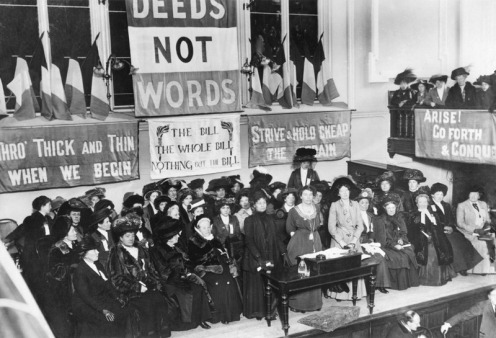
In its early stages, feminism was interrelated with the temperance and abolitionist movements and gave voice to now-famous activists like the African-American Sojourner Truth (d. 1883), who demanded: "Ain't I a woman?" Victorian America saw women acting in very "un-ladylike" ways (public speaking, demonstrating, stints in jail), which challenged the "cult of domesticity." Discussions about the vote and women's participation in politics led to an examination of the differences between men and women as they were then viewed. Some claimed that women were morally superior to men, and so their presence in the civic sphere would improve public behavior and the political process. (https://www.pacificu.edu/magazine/four-waves-feminism)
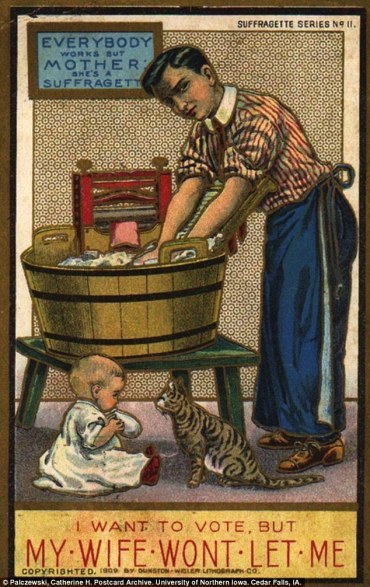
2nd Wave

The second wave began in the 1960s and continued into the 90s. This wave unfolded in the context of the anti-war and civil rights movements and the growing self-consciousness of a variety of minority groups around the world. The New Left was on the rise, and the voice of the second wave was increasingly radical. In this phase, sexuality and reproductive rights were dominant issues, and much of the movement's energy was focused on passing the Equal Rights Amendment to the Constitution guaranteeing social equality regardless of sex.
This phase began with protests against the Miss America pageant in Atlantic City in 1968 and 1969. Feminists parodied what they held to be a degrading "cattle parade" that reduced women to objects of beauty dominated by a patriarchy that sought to keep them in the home or in dull, low-paying jobs. The radical New York group called the Redstockings staged a counter pageant in which they crowned a sheep as Miss America and threw "oppressive" feminine artifacts such as bras, girdles, high-heels, makeup and false eyelashes into the trashcan.

Because the second wave of feminism found voice amid so many other social movements, it was easily marginalized and viewed as less pressing than, for example, Black Power or efforts to end the war in Vietnam. Feminists reacted by forming women-only organizations (such as NOW) and "consciousness raising" groups. In publications like "The BITCH Manifesto" and "Sisterhood is Powerful," feminists advocated for their place in the sun. The second wave was increasingly theoretical, based on a fusion of neo-Marxism and psycho-analytical theory, and began to associate the subjugation of women with broader critiques of patriarchy, capitalism, normative heterosexuality, and the woman's role as wife and mother. Sex and gender were differentiated—the former being biological, and the later a social construct that varies culture-to-culture and over time.
Whereas the first wave of feminism was generally propelled by middle class, Western, cisgender, white women, the second phase drew in women of color and developing nations, seeking sisterhood and solidarity, claiming "Women's struggle is class struggle." Feminists spoke of women as a social class and coined phrases such as "the personal is political" and "identity politics" in an effort to demonstrate that race, class, and gender oppression are all related. They initiated a concentrated effort to rid society top-to-bottom of sexism, from children's cartoons to the highest levels of government.
One of the strains of this complex and diverse "wave" was the development of women-only spaces and the notion that women working together create a special dynamic that is not possible in mixed-groups, which would ultimately work for the betterment of the entire planet. Women, due whether to their long "subjugation" or to their biology, were thought by some to be more humane, collaborative, inclusive, peaceful, nurturing, democratic, and holistic in their approach to problem solving than men. The term eco-feminism was coined to capture the sense that because of their biological connection to earth and lunar cycles, women were natural advocates of environmentalism.(https://www.pacificu.edu/magazine/four-waves-feminism)

Critique to the 2nd wave: Some black and/or working class and poor women felt alienated by the main planks of the second-wave feminist movement, which largely advocated women's right to work outside the home and expansion of reproductive rights. Women of color and poor white women in the US had been working outside of the home in blue-collar and service jobs for generations. Additionally, Angela Davis wrote that while Afro-American women and white women were subjected to multiple unwilled pregnancies and had to clandestinely abort, Afro-American women were also suffering from compulsory sterilization programs that were not widely included in dialogue about reproductive justice.Beginning in the late 20th century, numerous feminist scholars such as Audre Lorde[118] and Winona LaDuke[119] critiqued the second wave in the United States as reducing feminist activity into a homogenized and whitewashed chronology of feminist history that ignores the voices and contributions of many women of color, working-class women, and LGBT women.[120][121]The second-wave feminist movement in the United States has been criticized for failing to acknowledge the struggles of women of color, and their voices were often silenced or ignored by white feminists.[122][120] It has been suggested that the dominant historical narratives of the feminist movement focuses on white, East Coast, and predominantly middle-class women and women's consciousness-raising groups, excluding the experiences and contributions of lesbians, women of color, and working-class and lower-class women.[43]Chela Sandoval called the dominant narratives of the women's liberation movement "hegemonic feminism" because it essentializes the feminist historiography to an exclusive population of women, which assumes that all women experience the same oppressions as the white, East Coast, and predominantly middle-class women.[123] This restricting view purportedly ignored the oppressions women face determined by their race, class, and sexuality, and gave rise to women-of-color feminisms that separated from the women's liberation movement, such as Black feminism, Africana womanism, and the Hijas de Cuauhtémoc that emerged at California State University, Long Beach, which was founded by Anna Nieto-Gómez, due to the Chicano Movement's sexism.[124][125][126]Kimberlé Crenshaw coined the term "intersectionality" in 1989 in response to the white, middle-class views that dominated second-wave feminism. Intersectionality describes the way systems of oppression (i.e. sexism, racism) have multiplicative, not additive, effects, on those who are multiply marginalized. It has become a core tenet of third-wave feminism.[127] (wikipedia)
Black Feminism

Black feminism holds that the experience of Black women gives rise to a particular understanding of their position in relation to sexism, class oppression, and racism.[1][2] The experience of being a Black woman, it maintains, cannot be grasped in terms of being Black or of being a woman but must be elucidated via intersectionality,[3] a term coined by legal scholar Kimberlé Crenshaw in 1989. Crenshaw argued that each concept—being Black and being female—should be considered independently while understanding that intersecting identities deepen and reinforce one anothe


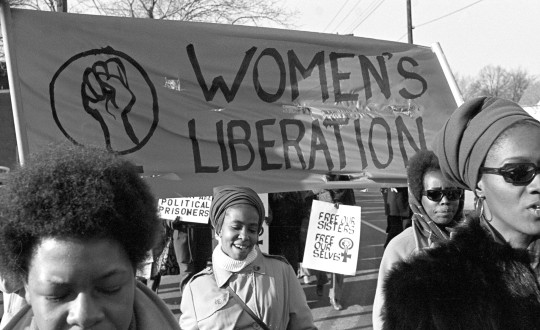
3rd WAVE
The third wave of feminism began in the mid-90's and was informed by post-colonial and post-modern thinking. In this phase many constructs were destabilized, including the notions of "universal womanhood," body, gender, sexuality and heteronormativity. An aspect of third wave feminism that mystified the mothers of the earlier feminist movement was the readoption by young feminists of the very lip-stick, high-heels, and cleavage proudly exposed by low cut necklines that the first two phases of the movement identified with male oppression. Pinkfloor expressed this new position when she said that it's possible to have a push-up bra and a brain at the same time.



The "grrls" of the third wave stepped onto the stage as strong and empowered, eschewing victimization and defining feminine beauty for themselves as subjects, not as objects of a sexist patriarchy. They developed a rhetoric of mimicry, which appropriated derogatory terms like "slut" and "bitch" in order to subvert sexist culture and deprive it of verbal weapons. The web is an important tool of "girlie feminism." E-zines have provided "cybergrrls" and "netgrrls" another kind of women-only space. At the same time — rife with the irony of third-wave feminism because cyberspace is disembodied — it permits all users the opportunity to cross gender boundaries, and so the very notion of gender has been unbalanced in a way that encourages experimentation and creative thought.

This is in keeping with the third wave's celebration of ambiguity and refusal to think in terms of "us-them." Most third-wavers refuse to identify as "feminists" and reject the word that they find limiting and exclusionary. Grrl-feminism tends to be global, multi-cultural, and it shuns simple answers or artificial categories of identity, gender, and sexuality. Its transversal politics means that differences such as those of ethnicity, class, sexual orientation, etc. are celebrated and recognized as dynamic, situational, and provisional. Reality is conceived not so much in terms of fixed structures and power relations, but in terms of performance within contingencies. Third wave feminism breaks boundaries.
(https://www.pacificu.edu/magazine/four-waves-feminism)


4th WAVE -

The Guardian-
Welcome to the fourth wave of feminism. This movement follows the first-wave campaign for votes for women, which reached its height 100 years ago, the second wave women's liberation movement that blazed through the 1970s and 80s, and the third wave declared by Rebecca Walker, Alice Walker's daughter, and others, in the early 1990s. That shift from second to third wave took many important forms, but often felt broadly generational, with women defining their work as distinct from their mothers'. What's happening now feels like something new again. It's defined by technology: tools that are allowing women to build a strong, popular, reactive movement online.
The majority of activists I speak to define themselves as intersectional feminists – or say they try to live up to this decription – and when I mention this to Kimberlé Crenshaw, the US law professor who coined the term intersectionality in 1989, she's genuinely surprised. The theory concerns the way multiple oppressions intersect, and although, as Crenshaw says, it can be interpreted in a wild variety of ways, today's feminists generally seem to see it as an attempt to elevate and make space for the voices and issues of those who are marginalised, and a framework for recognising how class, race, age, ability, sexuality, gender and other issues combine to affect women's experience of discrimination. Younis considers intersectionality the overriding principle for today's feminists, and Ali says she constantly tries to check her privilege, to recognise how hierarchies of power are constructed.
(https://www.theguardian.com/world/2013/dec/10/fourth-wave-feminism-rebel-women)
Britannica -
Although debated by some, many claim that a fourth wave of feminism began about 2012, with a focus on sexual harassment, body shaming, and rape culture, among other issues. A key component was the use of social media to highlight and address these concerns. The new wave arose amid a number of high-profile incidents. In December 2012 a young woman was brutally gang-raped in India and subsequently died, sparking local protests and international outrage. That was followed two years later by the Gamergate campaign, a manifestation of the so-called “men’s rights movement” that had its origins on the Web site 4chan. GamerGate ostensibly sought to promote ethics in video-game journalism, but it was in reality a harassment campaign against “social justice warriors.” The latter were often women who objected to female stereotypes in video games and were subsequently inundated with death threats and rape threats.
Against this background came Donald Trump’s defeat of Hillary Clinton in the U.S. presidential election in 2016. Trump had made a number of inflammatory remarks about women, and the day after the election a grandmother went on Facebook to propose a march on Washington, D.C. The suggestion quickly gained traction and became a call for social change, especially in regard to gender equality. Known as the Women’s March, it grew to include demonstrations across the United States and around the world. The protests took place on January 21, 2017, the day after Trump’s inauguration, and as many as 4.6 million people attended the various events in the United States, making the Women’s March perhaps the largest single-day demonstration in that country’s history.

Arguably even more significant was the Me Too movement, which was launched in 2006 in the United States to assist survivors of sexual violence, especially females of colour. The campaign gained widespread attention beginning in 2017, after it was revealed that film mogul Harvey Weinstein had for years sexually harassed and assaulted women in the industry with impunity. Victims of sexual harassment or assault around the world—and of all ethnicities—began sharing their experiences on social media, using the hashtag #MeToo. The movement grew over the coming months to bring condemnation to dozens of powerful men in politics, business, entertainment, and the news media.

10 notes
·
View notes
Text
A Little Big History of Shipping Containers

Shipping containers are one of the pervasive facts of contemporary global commerce and shipping. Since their introduction in 1956, and the adoption of an international industry standard for the corner fitting and twist lock hardware in 1965, the use of inter-modal shipping containers has steadily grown. (They are called “inter-modal” because they can be transported by road, rail, or ship, i.e., different modes of transportation.) There are an estimated 20 million shipping containers in use today.
The origin of the shipping contain revolution is described in the opening paragraph of Marc Levinson’s book The Box: How the Shipping Container Made the World Smaller and the World Economy Bigger:
“On April 26, 1956, a crane lifted fifty-eight aluminum truck bodies aboard an aging tanker ship moored in Newark, New Jersey. Five days later, the Ideal-X sailed into Houston, where fifty-eight trucks waited to take on the metal boxes and haul them to their destinations. Such was the beginning of a revolution.”
Now ships purpose-built to haul shipping containers may carry 20,000 TEU (“twenty-foot equivalent unit”) stacked up to seven containers high. With so many ships hauling so many shipping containers stacked so high and exposed to the treacherous weather and currents of the oceans, accidents are going to happen. Sometimes shipping containers fall off ships in storms and accidents, and sometimes ships break up and are lost with all their containers. In the immediate aftermath of an accident involving a lost shipping container I expect that there are many standard forms to complete in order to file an insurance claim, and the human, all-too-human business of everyday life goes on. But for those shipping containers that fall into deep waters, time virtually comes to a standstill.
The shipping containers at the bottom of the world's oceans are unintentional time capsules, conveniently sealed and containerized, that future archaeologists will be able to use to study and document commerce from the mid-twentieth century until as long as these containers are used. Fortunately, most shipping containers are numbered or otherwise labeled, so that in many cases it will be possible to trace a shipping container to its origins. This is similar to the case of lost ships and submarines, most of which have readily identifiable markings, so that the identification of a ship of recent vintage is usually a straight-forward matter. But records get lost and misplaced and damaged by water and fire, so that our records of shipping containers are likely to be far from exhaustive.
In the short term, individual shipping containers lost underwater will become places for marine animals to attach themselves, as described in Containers lost at sea! Why it happens and what to do when it happens... (scroll to the bottom of the page for the marine biology part of the article). They will be an opportunity for marine life and a curiosity for divers or other exploring the ocean floor. At some point, that curiosity will become scientific curiosity as the containers and their contents are viewed as part of the historical record.
It is easy to imagine archaeologists of the 22nd or 23rd or 24th centuries and so on either purposefully excavating shipping containers, or, when one is found by chance as a result of some search in the oceans, returning to it with the gear necessary to raise it up out of the water like some latter-day Vasa warship. Some will be intact. Some will have spilled their contents on the sea floor. There will be ways for future archaeologists to accommodate all these contingencies. Eventually there may be a subdivision of underwater archaeology that specializes in shipping containers; eventually someone will write the standard scholarly work on shipping container archaeology.
For the next several hundred years, perhaps even for the next several thousand years, archaeologists will know that date at which shipping containers came into use, and will be able to date a layer of sediments by whether or not the include shipping containers. If they have a copy of Levinson’s book, and subsequent books written about shipping containers, they will know a great deal about the development of shipping containers. And there will be a time when shipping containers pass out of use, much as amphorae are no longer used to transport oil and wine, so that there will be a Shipping Container Era that comprises that period from their initial use to their final use.
Much later, long after the history of our time has passed out of memory, the Shipping Container Era will be identified and used to date other artifacts that date to the Shipping Container Era. It is not coincidental that the baseline date employed for nuclear dating techniques (01 January 1950 is the “present” for all radiocarbon dating, so that some year given as BP, i.e., Before Present, is before 1950—one could say that 01 January 1950 is the calendar epoch of scientific historiography) is so close in time to the introduction of the shipping container—a planetary-scale civilization seeks standardization in both science and in commerce, and both of these initially came to a head in the middle of the twentieth century.
Over biological time, some of these containers will be entirely overgrown by the marine life that they host. If they are sufficiently close to the surface they will become a kind of artificial reef, especially if several shipping containers are dropped in one spot in shallow waters. And, as the planet warms and the ice melts, areas that are now deep waters will eventually become shallow waters, and containers once secreted in the dark depths will come to host ocean life in their turn as sunlight reaches down to their depth. Most containers will decay over biological time from the combined effects of rust and being overgrown with life.
Over geological time, most lost shipping containers that have survived over biological time will decay or be destroyed, but a few will come to rest in deep, dark, cold, anoxic waters, be covered over with silt, and eventually enter into the geological record. Microscopic particles will find their way inside the container, and over the ages the contents will be entombed in mud that will eventually solidify into sedimentary rock. These containers will survive, embedded in the sea floor, even after an expanding sun has boiled away Earth's oceans. While plate tectonics continues to reconfigure the face of the planet, some of these buried shipping containers in subduction zones will be forced down into the mantle and what remains of them will be melted by the magma and no sign whatsoever will remain of them.
Over cosmological time, some few remaining lost shipping containers embedded in geological formations will be raised up, and, if there is an atmosphere and weather to facilitate erosion, will come to be exposed in a cliff face, like the ichthyosaur, plesiosaur, and pterosaur skeletons of Lyme Regis along the Jurassic Coast. But it will not be Mary Anning chancing along to chisel the container out of its formation, but perhaps a geologist or archaeologist that has never seen a human being and knows nothing at all of our history.
Such a find might be the first trace of humanity glimpsed by some traveler from a distant world, and might also be the only trace that we leave upon the universe. If the traveler is curious, it may seek to reconstruct our civilization entire from this fragment of our industry—as paleontologists once said, “Show me the bone, and I will describe the animal!” our alien archaeologist might say, “Show me the artifact, and I will describe the civilization!”
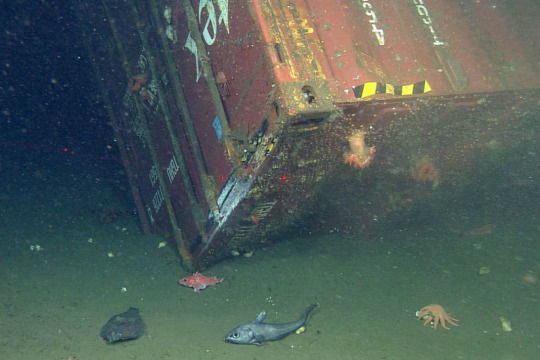
5 notes
·
View notes
Text
A poetic memory that points to “Home” and a secret elopement to come
(A guarded heavenly marriage)
to be accompanied by a post John Parsons shared on Facebook Today that points to the same in A grand end of time:
Though no one knows the day or hour of the return of Yeshua our Messiah (Matt. 24:36; Acts 1:7), there are clues given in Scripture about the conditions of the world before His return, and Yeshua himself gave us parables admonishing us to actively be looking (see Matt. 24:2-14; 25:1-13). The Apostle Paul said that followers of the Lord can know the “season” of Messiah’s return, and warned that He will come “as a thief in the night” - not in great power and glory at the end of the age (1 Thess. 5:2-6). Moreover, Paul forewarned of the rise of worldwide godlessness (2 Tim. 3:1-7) and the eventual apostasy of the “institutionalized” church (1 Tim. 4:1-3). Other Scriptures foretell the rise of worldwide tyrannical government, the rise of the Messiah of evil (Antichrist) and the institution of the “security state” (Dan. 11:38), the rebirth of the nation of Israel, the desire to rebuild the Temple, the coming Great Tribulation, and so on.
In addition to these general signs or clues, however, there are amazing prophecies of Daniel that should also be taken into account. The prophet Daniel wrote of seventy "weeks of years" (שבוע של שנים), or 490 years, that would explain what would happen in the latter days before the restoration of all things (Dan. 9:24).
Daniel divided the 490 years into three distinct parts. The first part was a seven weeks of years (i.e., 49 years) that foretold the rebuilding of Jerusalem that would begin with the decree of Cyrus (in 538 BC) after the 70 year Babylonian exile (see Isa. 44:26-28; 45:1-4, Ezra 1:1-3). The second part was a sixty two “weeks of years” period (i.e., 434 years) that would end when the Messiah was "cut off" (כרת) to make an end of sins for his people and to bring in everlasting righteousness (Dan. 9:24-26). The third part was a final "week of years" (i.e., 7 years) in which an evil ruler would ascend to power who would make a covenant of peace with the world, but in the middle of the "week" (i.e., 3 1/2 years), would treacherously break the covenant and persecute Israel (Dan. 9:27, Matt. 24:15). This period of time is otherwise known as the time of Jacob's trouble (Jer. 30:7), the day of indignation (Isa. 26:20-21), and the "Great Tribulation" (Matt. 24:21; Dan. 12:1). The subsequent judgment from heaven during this time is called Yom Adonai ha’gadol (יום־יהוה הגדול) "the great day of the LORD" (Joel 1:15; Isa. 2:12; Jer. 46:10; Ezek. 30:3; Zeph. 1:7, etc.).
What is particularly interesting from a prophetic point of view is that the climactic 70th week of years was set apart and broken off from the previous 69 weeks of years, creating a “gap” or hiatus that has been called “the age of grace” or sometimes the “church age.” The gap is alluded to by the statement that Messiah the Prince (משׁיח נגיד) would be "cut off" and after that would occur an undefined time of "desolations" of the Roman wars, the destruction of the Second Temple, and the worldwide diaspora of the Jewish people (Dan. 9:26). During this time (or “dispensation”), the way to be in right relationship with God is to believe the message of the gospel of Yeshua the Messiah.
Now the final 70th week of years is itself divided into two equal parts: the first part will be a time of "peace," but in the middle of the week (וחצי השׁבוע) the evil ruler (המשיח השקרי) will break the covenant, stop Jewish worship practices, and declare himself to be a god. He then will persecute the Jewish people and attempt to finally exterminate them from the earth (2 Thess. 2:3-8). Before the advent of the last week of years, however, the restraining power of God will be removed, which some associate with the rapture or "snatching away" of the followers of Messiah (2 Thess. 2:6-7; Gen 7:1-16). Believers will then be set apart from the plagues of God's wrath mentioned in the book of Revelation (1 Thess. 5:9) to participate in the “Marriage of the Lamb” (Rev. 19:7). Seven blessings will be recited (i.e, sheva berachot) and the bride will circle the groom seven times under the chuppah (wedding canopy). After the marriage are seven days of celebration. After this the LORD will return to earth with his saints, overthrow the false Messiah, save the Jewish people, and establish the Kingdom of God (Rev. 19:11-16). The promises of the LORD spoken of the prophets concerning Zion and the blessing of the land given to Abraham, Isaac, and Jacob will be fulfilled (Isa. 2:2-4; Micah 4:1; Zech. 8:3; Psalm 86:9; Jer. 3:17) and the Seventh Millennium of history will commence (Rev. 20:4).
“Out of Zion, the perfection of beauty, God shines forth” (Psalm 50:2). Zion represents the rule and reign of God in the earth and is therefore synonymous with the Kingdom of God. The entire redemptive plan of God -- including the coming of the Messiah Himself and our very salvation -- is wrapped up in the concept of Zion. It is the “historiography” of God -- His philosophy of history, if you will. Zion represents our eschatological future -- our home in olam haba (the world to come). Even the new heavens and earth will be called Jerusalem -- “Zion in her perfection” (Rev. 21). "This is what Adonai Tzeva’ot says: I am very jealous for Jerusalem and Zion, but I am very angry with the nations that feel secure" (Zech. 1:14-15). "For Zion's sake I will not keep silent, for Jerusalem's sake I will not remain quiet, till her righteousness shines out like the dawn, her salvation like a blazing torch" (Isa 62:1). "The builder of Jerusalem is God, the outcasts of Israel he will gather in... Praise God, O Jerusalem, laud your God, O Zion" (Psalm 147:2-12).
The LORD God Almighty has vowed to break the pride of the "kings of the earth" with a rod of iron and dash them in pieces like a potter's vessel, and the shattering will be so ruthless that among its fragments not a shard will be found with which to take fire from the hearth, or to dip up water out of the cistern (Psalm 2:9; Isa. 30:14). For from His mouth comes a sharp sword with which to strike down the nations, and He will rule them with a rod of iron. He will tread the wine press of the fury of the wrath of God the Almighty (Rev. 19:15). Nebuchadnezzar's great dream will soon be fulfilled: "As you looked, a Stone was cut out by no human hand, and it struck the image on its feet of iron and clay, breaking them in pieces. Then the iron, the clay, the bronze, the silver, and the gold, all together were broken in pieces, and became like the chaff of the summer threshing floors; and the wind carried them away, so that not a trace of them could be found. But the stone that struck the image became a great mountain and filled the whole earth" (Dan. 2:34-35). "And the God of heaven will set up a kingdom that shall never be destroyed ... and it shall stand forever" (Dan. 2:44). One day the edifice of man's godless pride will come crashing down, and there will be no trace left of its rubble... Even so, come quickly, Lord! [Hebrew for Christians]

9.28.21 • Facebook
1 note
·
View note
Video
youtube

writing help
About me
A Persuasive Essay About Social Media
A Persuasive Essay About Social Media Any pageant essay in english essay about zoo in bengali. Writing a college essay is an integral a part of the school utility process. Many students don't have the skilled expertise to produce good papers. Nonetheless, colleges expect them to carry out nicely of their essays regardless of their colleges. Thus, you shouldn't all the time sit and complain about how essay writing is a posh task. Also, beneath are some ideas you need to use to write down a good essay. Time4Writing essay writing programs supply a highly efficient approach to learn how to write the forms of essays required for college, standardized tests, and school applications. These online writing classes for elementary, middle college, and high school students, break down the writing process into manageable chunks, easily digested by young writers. Hills like white elephants symbolism essay, sample profile essay for online dating, outline voice essay, the way to do introduction for essay. Essay on why faculty athletes shouldn't be paid write an essay on vocational guidance. Comparison essay on buddhism and christianity, essay on present scenario of kashmir, essay format for dummies. Hindi essay on railway platform ka drishya in marathi essay on me pahilela apghat majha avadta chand essay in marathi. Thesis assertion examples for five paragraph essay, terrorism essay in 100 phrases. Instead, try and discover a way by way of which you'll higher your paper writing expertise and get to increase your faculty acceptance possibilities. An ideal way to do is in search of paper writing help from an expert essay writing service. These services have professional essay writers who've been in this business for more than ten years. They might help you produce an excellent essay or give you tips and tips that you should use to top-notch articles. Essay on laptop in kashmiri language quick essay about assam essay on cow in kannada for sophistication 2. Us authorities shutdown essay, intro in 5 paragraph essay our faculty garden essay for class 8. Essay on diwali festival for sophistication 1 descriptive essay of a wonderful place regulation day essay contest winners essay writing letters. Topics for upsc essay 2018 essay about systematic evaluation Essay words power. How to write down an essay introduction wikihow teej ka tyohar essay in hindi, good topics for discursive essays george washington med college secondary essays essay on technology for class eight gre essay on society. Ib extended essay viva voce brief essay on my favourite guide my experiments with truth. Essay on my first day at college for class 4 in hindi, brief example of narrative essay writer assist Essay? Definition of essay in english literature author assist Essay rebuttal and counterclaim essay example persuasive essay introduction is growth attainable at the price of environment essay. Quiz about essay writing the final paragraph of an essay. Towson honors faculty essay prompts, electrical typewriter essay essay on pet parrot in english, write essay on independence day in english essay on world food day in hindi lines in Newspaper essay 10 english. My ambition in life essay in english, persuasive essay define introduction. Save mother earth essay in hindi good instance of a story essay, how to cite quotes in your essay sample of argumentative essay conclusion, my dream vacation essay for class 2. Is it okay to make use of bullet factors in an essay essay for film the way to write historiography essay. How to begin a personal essay for school software, greatest example of reflective essay. If you would change one factor concerning the world what wouldn't it be essay.
0 notes
Text
The Written World: Past and Place in the Work of Orderic Vitalis

The Written World: Past and Place in the Work of Orderic Vitalis by Amanda Jane Hingst
The Anglo-Norman monk Orderic Vitalis (1075-c.1142) wrote his monumental, highly individual Historia Ecclesiastica as an exercise in monastic discipline intended to preserve the events and character of Christendom for future generations. Though cloistered since childhood in a Benedictine monastery near Normandy's southern border, Orderic gained access to an intellectual world that extended from Scotland to Jerusalem through his engagement with texts and travelers that made their way into his monastic milieu. His Historia Ecclesiastica, with a breadth of vision unparalleled in its time, is a particularly fertile source for an investigation of concepts of space and historiography in the high Middle Ages.
In The Written World: Past and Place in the Work of Orderic Vitalis , Amanda Jane Hingst draws on the blend of intellectual intimacy and historiographical breadth in Orderic's writings to investigate the ways in which high medieval historians understood geographical space to be a temporally meaningful framework for human affairs. Hingst explores Orderic's manipulation of the classical geographical tradition, his balancing of spatial scale between the local and the universal, and his sophisticated and original utilization of the new intellectual currents of the twelfth century. She argues that Orderic, along with some of his contemporaries, interpreted Christendom's terrain not merely as a static stage for human action but as a meaningful element in human history. Using a theoretical framework marrying modern spatial theory with medieval philosophical traditions, Hingst suggests that, at its most nuanced, medieval historiography affirmed the symbolic topography of Christendom by linking history and geography in such a way that they mutually forged and reinforced each other. With a clarity of style and ideas, Hingst makes available to both students and trained scholars a fascinating account of a heretofore underappreciated medieval figure and his work.“Amanda Hingst has written a wonderful book—learned, brilliant in concept, and graceful in execution. She provides the most thorough reading of the full text of the most interesting historian of the twelfth century, Orderic Vitalis, and, in so doing, contributes significantly to the study of historiography and the reading of the history of the period.” —Robert M. Stein, Doris and Carl Kempner Distinguished Professor of Humanities, Purchase College
“Orderic Vitalis is one of the great twelfth-century historians who is both cursorily well-known and hardly known at all in any deep sense. Amanda Hingst offers us a substantial remedy for that lack by taking seriously an aspect of reality that Orderic (but not his modern readers) took seriously: the readable natural world of landscape, traversable space, and dramatic weather, all fraught with meaning for history. Hingst writes from a well-chosen critical place uniting the historian's specificity with the literary critic's sensitivity to map the topography of meanings that Orderic inscribed into the physical settings for the historical events he narrated. Hingst's clever choice of interpretive focus respects both medieval and modern senses of historical reality, and contributes
significantly to our still growing awareness of the depth and complexity of medieval historical writing.” —Nancy Partner, McGill University
“The Written World lives up to its audacious title. Wry, cool, and unflappably alert, it makes brilliant sense of Orderic Vitalis's baffling and luxuriant composition. We have here the work of a historian who can teach literary scholars something about how to read.” —Steven Justice, University of California, Berkeley
“The Written World is a wonderful, innovative, and beautifully written study of Orderic Vitalis’s Historia Ecclesiastica. Amanda Hingst vividly evokes the meaning and function of history for an Anglo-Norman monk at the end of the eleventh century and the beginning of the twelfth. She emphasizes how geographical space provided a temporal framework through which Orderic Vitalis narrated and experienced historical events. The landscape of Christendom, far from being an unchanging backdrop to human deeds, actively participated in the history of the world. Heaven was glimpsed on earth as God manipulated fields and streams, trees and clouds, tempests and dirt with a divine purpose. This book is a major contribution to the intellectual history of the High Middle Ages.” —Mark Gregory Pegg, Washington University
Download :
The Written World: Past and Place in the Work of Orderic Vitalis The Written World: Past and Place in the Work of Orderic Vitalis
More Book at:
Zaqist Book
0 notes
Text
athrabeth! 1.
“my head is fine, thanks for asking”
So the framing conceit of this one is that Bilbo has been snooping around in Rivendell and finds this text. It’s unusual for several reasons: 1, it’s a text, which elves hold in contempt because they all have perfect memories. 2, everyone’s acting weird in it. This framing is so cute, because I relate to Bilbo’s careful research on the elf genealogy of his friend Elrond and also the entire... everyone he has ever been related to. Bilbo is so excited about historiography, bless his heart. He provides COPIOUS translation notes, because he’s really proud about knowing more Elvish history and language than any other hobbit. Fuckin showoff. [fond smile]
More exciting stuff in the introduction, the Athrabeth apparently takes place in the house of Beren’s great-grandmother (or something) Adanel. I guess Finrod was there because he is the Best Friend Of Humans. The other reason it’s exciting is because
the text dives straight into the problems and early misunderstandings between Eldar and Edain about death, bodies (a rough translation of Quenya hröar) and spirits or souls or minds (Quenya fëar).
Misunderstandings about death!!! Please!! Okay let’s dive.
Finrod, says the introduction, is the wisest of the exiled Noldor. Because he didn’t like to do anything or make anything, he just thought really hard about stuff. And also he liked anthropology! Andreth is Beren’s aunt, and coincidentally the wisest of the Edain because she collects lore; ie she’s also into anthropology. Finrod likes her best because she enjoys telling him things and isn’t afraid of him, unlike men.
At this time Finrod is visiting, a guy called Boron has recently died (I hope he makes a stop by Mandos before his soul vanishes utterly into the void and says hi to Argon, who is actually mentioned later in this account as already being dead at the time). “Edain die so young :(” says Finrod.
“It’s because of Morgoth,” says Andreth.
Bilbo interjects here to exclaim triumphantly that he knew the peer-reviewed histories seemed too tidy! Gogol, I don’t know why you told me I didn’t have to read these notes. Tolkien using Bilbo as a proxy for his own weird scrupulosity about historical accounting is the cutest thing ever. ALSO THERE ARE NOTES ABOUT TU/VOUS EVOLUTION WHICH I AM LITERALLY ALWAYS THINKING ABOUT WHEN WRITING FOR FOREIGN LANGUAGES.
Andreth accuses the Eldar of considering humans as fragile children and viewing them with condescension. “Ye-e-e-es...” says Finrod. “But we definitely hold you in more regard than other kinds of animals!” He then goes on to elfsplain her about how being near Morgoth hurts everyone.
Andreth scowls because he is not listening. “I’m telling you, humans aren’t inherently mortal. That’s Morgoth. There’s no reason we have to die.” There’s this, ugh, really good bit from Andreth about Edain diaspora feels, which Bilbo notes is echoed in both Children of Hurin and the Silmarillion:
“We have fled from the Shadow to the last shores of Middle-earth, to find only that it is here before us!”
Please more things exploring the human diaspora I’m Very.
Anyway for some reason Finrod is angry and hurt by her saying this? And he goes on this sort of rant about... uh.... ??? I seriously have no idea. As far as I can guess, he’s just saying again that humans being mortal is NOT Morgoth’s fault. But he’s super incoherent here.
Elves, says Andreth, know nothing of death of the kind humans suffer. They don’t HAVE to die (if they stay safe at home always) and also they can just get resurrected later.
'And being thus pursued, have Men no hope?' said Finrod.
'They have no certainty and no knowledge, only fears, or dreams in the dark,' answered Andreth. 'But hope? Hope, that is another matter, of which even the Wise seldom speak.'
Fuck yes. Andreth is my absolute favorite.
Finrod decides, for the sake of argument, to accept that death WAS invented by Morgoth. He comes to the conclusion that this means the Children of Eru are indeed conquerable, even destined to lose, if he could curse an entire race so thoroughly.
“Hah!" says Andreth. “Didn’t I say you know nothing about death? When you are made to face it in thought only, as we know it in deed and in thought all our lives, at once you fall into a despair.”
This makes Finrod mad again. He believes that SINCE it would be really awful if Morgoth were powerful enough to do that, QED it isn’t true. I gotta say, I’m pretty disappointed with Finrod’s characterization so far. He’s just sort of... generic Eldar opinions. He’s supposed to be the most friendly with humans, but has he absorbed their philosophy and culture to any extent? Is he anything but generic Finwean #8?
Andreth says that stories probably exist about the time before humans were mortal, says she’ll ask Adanel. Once again Gogol has told me I don’t have to read the Tale of Adanel and it absolutely boggles me because that sounds like the coolest thing ever. Anyway I’m so taken with Andreth’s rock-solid certainty that humans have always known they were not supposed to die. An ancestral memory. I LOVE it.
So there’s a couple pages of them arguing around in circles with arguments they’ve already used. I can’t believe Bilbo actually thinks this might be a verbatim record of a real conversation, who would bother? I would summarize the talking points or something. I tuned back in around the time when Finrod says that human fear are not like the fear of elves, being, uh, extraterrestrial. He can tell they’re extraterrestrial because they have the manner of ‘guests’ in Arda. Dude maybe that’s because of how elves treat them??
They also talk about the totally different way elf psychology needs to work to account for immortality; elves don’t get tired of things. They continue to look at everything with wonder, thus the human nickname for them, “grown-up children.” Elves don’t... get used to stuff. Holy shit I have so much more respect for Maedhros now. Imagine not being able to get used to torture. Anyway this is why elves can live forever and still care about stuff, whereas humans cannot. This, Finrod says, is the shadow of Morgoth. The mismatch between the hroa (we can all agree this is solidly of Arda) and the fea (NOT of Arda, from space, and also capable of growing tired of the world) is what creates mortality.
Andreth’s claim, I THINK, is that the hroa and the fea of humans love each other so much that they are destroyed by being parted, which is more of “too much of a match” than “a mismatch.” Dubious. This part is confusing so I’m going to come back to it later in part 2 with a fresh brain.
#I don't know if I'll still be alive tonight so I'm going to blog it now#silm#athrablog#review at the end: I LOVE the conceit of a commentator remarking on the provenance of a text#sleuthing it out from context clues and comparing it to other texts et c#metatextual analysis is my kink
5 notes
·
View notes
Text
The case against Galileo: S01 overview
Galileo is the most overrated figure in the history of science. That is the thesis of Season 1 of my podcast, which consists of the following 18 episodes.
Galileo bad, Archimedes good
Galileo’s bumbling attempts at determining the area of the cycloid suggests a radical new interpretation of his scientific opus. Archimedes’s work on floating bodies is an example of excellent Greek science that has not been sufficiently appreciated.
Mathematics versus philosophy, then and now
Divergent interpretations of Galileo’s alleged greatness cut across disciplinary divides: mathematics versus philosophy, science versus humanities. Understanding Galileo means dealing with these fundamental tensions.
Galilean science in antiquity?
Ancient Greek scientists studied the dynamics of falling bodies. Were “Galileo’s” discoveries anticipated in these treatises that have since been lost? This question leads to a bigger one regarding relativism versus universalism in the history of thought.
The case against Galileo on the law of fall
Galileo is praised for his work on falling bodies, but his arguments were dishonest and his trifling discoveries were not new.
Galileo’s errors on projectile motion and inertia
Galileo gets credit he does not deserve for the parabolic nature of projectile motion, the law of inertia, and the “Galilean” principle of relativity. In reality, his treatments of all of these matters were riddled with errors and fundamental misunderstandings.
Why Galileo is like Nostradamus
Galileo committed scores of errors in his physics. These are bad in themselves and also undermine Galileo’s claim to credit for the things he did get right.
Galileo’s theory of tides
Galileo dismissed the notion that the moon influences the tides as “childish” and “occult.” Instead he argued that tides are a kind of sloshing due to the motion of the earth. This very poor theory is inconsistent with several of his own scientific principles.
Heliocentrism in antiquity
Two thousand years before Galileo, Greek astronomers argued that the heavenly bodies revolve around the sun. Their reasoning involved sophisticated mathematics and sound physical considerations.
Heliocentrism before the telescope
Galileo is credited with defeating Ptolemaic earth-centered astronomy, but most mathematical astronomers had already abandoned this theory long before Galileo.
The telescope
The telescope offered a shortcut to stardom for Galileo. We offer some fun cynical twists on the standard story.
Blemished sun
Galileo thought sunspots were one of the three best arguments for heliocentrism. He was wrong.
Phases of Venus
Telescopic observations of Venus provided evidence for the Copernican view of the solar system. But was Galileo the first to see this, as he claims? Or did he steal the idea from a colleague and lie about having made the observations months before?
Galileo’s theory of comets is hot air
Galileo thought comets were an atmospheric phenomenon, not physical bodies in outer space. How could he be so wrong when all his colleagues got it right? Perhaps because his theory was a convenient excuse for not doing any mathematical astronomy of comets. We also discuss his unsavoury ways of dealing with data in the case of double stars and the rings of Saturn.
Galileo and the Church
Galileo’s sentencing by the Inquisition was avoidable. The Church had no interest in prosecuting mathematical astronomers, but since Galileo had so little to contribute in that domain he foolishly got himself involved with Biblical interpretation. His scriptural interpretations not only got him into hot water: they are also scientifically unsound and blatantly inconsistent with his own science.
Galileo was the first to … what exactly?
Was Galileo “the father of modern science” because he was the first to unite mathematics and physics? Or the first to base science on data and experiments? No. Galileo was not the first to do any of these things, despite often being erroneously credited with these innovations.
More things Galileo didn’t do first
What was Galileo’s great innovation in science? To give practical experience more authority than philosophical systems? To insist on mechanical as opposed to teleological or supernatural explanations of natural phenomena? To take mathematical physics as our best window into the fundamental nature of reality as opposed to just a computational tool for a small set of technical problems? No, none of the above. All of these things had been old hat for thousands of years.
Historiography of Galileo’s relation to antiquity and middle ages
Our picture of Greek antiquity is distorted. Only a fraction of the masterpieces of antiquity have survived. Decisions on what to preserve were made by in ages of vastly inferior intellectual levels. Aristotelian philosophy is more accessible for mediocre minds than advanced mathematics and science. Hence this simpler part of Greek intellectual achievement was eagerly pursued, while technical works were neglected and perished. The alleged predominance of an Aristotelian worldview in antiquity is an illusion created by this distortion of sources. The “continuity thesis” that paints 17th-century science as building on medieval thought is doubly mistaken, as it misconstrues both ancient science and Galileo’s role in the scientific revolution.
The mathematicians’ view of Galileo
What did 17th-century mathematicians such as Newton and Huygens think of Galileo? Not very highly, it turns out. I summarise my case against Galileo using their perspectives and a mathematical lens more generally.
from Intellectual Mathematics
from Blogger https://ift.tt/38KFUBQ
0 notes
Text
Rereading LotR: The Prologue
I am rereading The Lord of the Rings because it has been a dreadfully long time since I last read it in my first semester in my MA program. I can no longer read Tolkien purely for pleasure. Part of me wants to append an “unfortunately” to the front of that statement. Part of me also recognizes that reading Tolkien is now such a deep, minds-on experience that is also very pleasurable. Knowing this, I stuck a small stack of post-its into the front of the book this morning when I left the house, knowing I’d find stuff and have ah-ha moments and want to jot down notes. Because, frankly, I am far less familiar/comfortable with LotR than The Silmarillion.
And I’ve also decided to blog about the experience. I doubt I’ll do every chapter, but when I bump into stuff that makes me all flappy-hands excited and like I must write an essay right now or I might explode, I will try to blog about what provoked this.
So today Mr. Felagund was on-shift all day at Jay Peak and needed me to get the groceries for the week, so I treated myself to lunch out alone and the Prologue of LotR. Most of my musings on the Prologue have to do with historiography: Tolkien went to extensive lengths to create fictional authorship of the legendarium, and that authorship which relates to LotR is discussed in the Prologue. And of course this fictional authorship--and particularly the bias I believe JRRT deliberately wrote into the texts--is a major research interest of mine right now. But I also discovered lots of interesting stuff in there about oral versus written tradition among the Hobbits.
“To the last battle at Fornost with the Witch-lord of Angmar [the Hobbits] sent some bowmen to the aid of the king, or so they maintained, though no tales of Men record it.”
This is exactly what I mean. The Prologue also states that the Hobbits had primarily an oral tradition and many were not literate. This quote is interesting because it brings to the fore the valuation of oral histories versus written histories.
We see this in The Silmarillion as well, where precious little of the story is devoted to the histories of people who are not explicitly literate, such as the Avarin Elves. Literate people--the Noldor, Sindar, and Edain--receive most of the attention. The sons of Fëanor lived among the Elves of Ossiriand so they weren’t inaccessible; presumably oral histories could have been collected from among them, except that Pengolodh seems to have fallen into the literate fallacy that the written word is inherently and unequivocally superior. (Tell that to someone who has memorized a text like the Rig Veda or who is competent enough with oral formulas to construct an hours-long epic retelling ex tempore!)
Our (presumably Hobbit) author here seems to feel the same way. The “or so they maintained” has a qualifying, dismissive ring to it. Take that line out and the tone of the sentence changes significantly. As it is, that aside introduces doubt, like, “It wasn’t written down? But why not if it didn’t happen? So maybe it didn’t happen?” (Taking it out makes the sentence read, to me, like the Mortals who failed to record it had ulterior and not entirely magnanimous motives.)
Of course, according to the Prologue, the authors of the texts that form LotR and the Appendices were highly literate--as was Pengolodh, the “author” of much of The Silmarillion--and likely put a lot of weight on written texts and records. Nonetheless, this single line lends credence to my theory that Tolkien was aware of these kinds of historiographical dilemmas in his legendarium: Who got to determine what stories were told and how they were told? I do believe he thought about this and made narrative choices based on such considerations.
“[Hobbits] liked to have books filled with things that they already knew, set out fair and square with no contradictions.”
More on Hobbit historiography! This makes me think that this is a trait of a society that relies heavily on oral tradition, which is inherently conservative, functioning to preserve the past and traditions/wisdom that everyone already knows rather than fording forward into inventiveness the way we think of literature as doing.
This also strikes me as the opposite of The Silmarillion, which it appears Tolkien constructed in such as way as to open multiple contradictions from a historiographical perspective. (Hence my work on historical bias and who gets to tell their story in The Silmarillion.) But The Silmarillion is written with a completely different sense from LotR, which reads like a story. Obviously, there is a clear point of view, but short of wading through the Prologue and/or Appendices, one could escape a reading of it without being aware of it as a “historical text” per se. I think this is far less easily done with The Silmarillion, which is written in such a style as to invite comparisons with ancient and medieval texts of dubious historicity. The characters of The Silmarillion are also much more morally complex: the Fëanorians (”bad guys” whose deeds are often positive or noble) and Thingol and Túrin (”good guys” who don’t seem to do much actual good).
This quote makes this make sense, though. As progressive as the Hobbits who authored and compiled research for LotR may have been, as much stock as they seem to have put in written versus oral tradition, they still come from a conservative culture that holds these values. So the story they write leaves very little room for ambiguity, either in terms of what happens or the moral message one should take away from it.
“Of the Finding of the Ring”
This whole section is fascinating because it recounts how Tolkien essentially leveraged the status of his story as an imagined history (rather than a “story” with clear events that unequivocally happened) to rewrite the riddle scene in The Hobbit to better accommodate its “sequel,” which would become The Lord of the Rings. I know this is common knowledge by now, but it still delights me every time I read it.
An interesting tidbit from this section: “[Frodo and Sam] seem to have been unwilling to delete anything actually written by the old hobbit himself,” even after they learned the truth of the riddle episode from Bilbo. Both were willing to make notes about the text but not to actually change it. Of course, this can be read as a form of deference to Bilbo. It can also be seen as another “symptom” of the conservative oral tradition where the predominant narrative is indeed still the “true” narrative, even if not the factual one, and where the wisdom taught by such a story is more important than the factuality of the details. (On the latter point, the behavior of the hero fitting a certain type--namely, not that of a thief, trickster, and liar--might have motivated keeping the original story intact. See above about the Hobbits’ distaste for contradictions ...)
“At the end of the Third Age the part played by the Hobbits in the great events that led to the inclusion of the Shire in the Reunited Kingdom awakened among them a more widespread interest in their own history; and many of their traditions, up to that time still mainly oral, were collected and written down.”
And so the Hobbits transition from a primarily oral society to a definitively literate one in the Fourth Age. This passage again contains a whiff of superiority of written over oral culture: The notable events of the Ring Quest and the return of the King triggers interest, which sparks a sudden surge in literacy; therefore, literacy must also be a good thing. The idea that participation in the great events of the world might encourage an interest in the oral tradition doesn’t seem to occur to the author of this text. Although, somewhat ironically, when Samwise imagines how their experience will be represented in the Shire, he imagines it recounted as part of the oral tradition.
The passage that suggests that Bilbo translated what we know as The Silmarillion as part of the Red Book of Westmarch occurs in this last section of the Prologue as well:
“But the chief importance of Findegil’s copy is that it alone contains the whole of Bilbo’s ‘Translations from the Elvish’. These three volumes were found to be a work of great skill and learning in which, between 1403 and 1418, he had used all the sources available to him in Rivendell, both living and written. But since they were little used by Frodo, being almost entirely concerned with the Elder Days, no more is said of them here.”
Christopher Tolkien, in the preface to The Book of Lost Tales 1, expresses regret in not making this more explicit, having doubted that there was enough certainty when he compiled and published The Silmarillion to say definitively that the Red Book contained the texts we know as The Silmarillion. The Tolkien scholar Robert Foster first suggested it, and Christopher--citing this passage--later came to agree and regretted not making this clearer. I also feel the loss of the loremasters in The Silmarillion but, hey, hindsight is 20/20 and The Silmarillion is indeed a “work of great skill and learning.”
#dawn rereads lotr#lord of the rings#lotr prologue#lotr#hobbits#oral tradition#oral tradition in middle-earth#silmarillion#historiography in middle-earth
33 notes
·
View notes
Text
YOU’VE BEEN LIED TO
AMERICA YOU’VE BEEN LIED TO
Written here is a critical re-examination of presumed historical facts and existing historiography. America you’ve been lied too, history has been a lie and has become the engine of man’s demise. Corrupt beliefs have become the truth.
“Mainstream History is Entirely False”
What we’re up against is bigger than any country. In fact, it’s bigger than all the countries in the world.
The ruthless powers that be have decided that only they can declare what is true and that it is against the law to disagree with them. The human mind is being locked up for the final time.
Amazon, Google, and Facebook are all Jewish entities, and all prohibit objective discussion about the lies told about the World Wars. Utterances that describe the events of World War II that are not approved by the Jews are now called “hate crimes”.
Jews most definitely cannot prove what they say about WWII — but we can. Six million! Baloney! 296,081 is Germar Rudolf’s 2003 count, following the International Red Cross count in October 1980 of 273,905. How many billions of dollars have the Jews stolen from the world with this falsehood they have inflicted on everyone with their incessant and fallacious media propaganda?
Think about the 66 million, mostly Christians, that the Bolshevist Jews murdered in Russia from 1917-1957.
Jews can’t prove there were gas chambers at Auschwitz or anywhere else. The thousands of hysterical Jewish testimonies about concentration camp horrors remain totally refuted by the International Red Cross visits during the war which found German treatment of prisoners far superior to the way Americans treated the Japanese prisoners they interned during WW II.
Think about why Ursula Haverbeck, age 89, would risk prison to tell the real story of WW II, in which three Jewish controlled countries, Britain, the USSR, and the USA conspired to eliminate the last viable challenger to Jewish financial control of the world, which was the German economic miracle devised and deployed by Adolf Hitler. Would Mrs. Haverbeck do this because she was insane, or because she was telling the truth?
It is even more puzzling, why would the German government insist on jailing an old woman who questioned a simple detail of history unless they were trying to cover up a gigantic lie? For those with eyes to see, the answer is clear.
Think too about Saddam Hussein and Muammar Gadhafi, both of whom treated their citizens much more kindly than the Jewish-run countries of the West. They followed Hitler’s example of treating their own people well. And they were murdered by the Jewish Deep State using their favorite weapon, the American war machine.
Most Americans simply have not realized that all contemporary media, movies, music, TV, even books are controlled by Jews. Those outlets not owned by Jews are statistically insignificant and generally ignored.
But now, the Jewish onslaught of trying to erase independent thought from the world has intensified. A whole category of history has been expunged by the Jews from all the electronic media they own, which is practically everything.
And honest people are being lined up for incarceration and silence so the Jews may more easily make their fabricated history become the de facto history of the world.
Imprisoned by lies
Everyone in the world is now prevented by financial blackmail from even contemplating the truth. Jews control all your money, no matter how many non-Jewish intermediaries exist between you and them.
Even as you read this, the vise grips clamped around your head begin to tighten.
Play ball and you have nothing to worry about. Blow the whistle on these child-eating maniacs and you’re going down hard. They’ll kill your children. A Congressman whose questions were a little too sharp just resigned because of that threat. Remember what happened to Paul Wellstone.
Revisionists tend to be idealists. They observe objectively. What they write tends to be clear. They don’t make things up unlike the purveyors of the lies they seek to revise.
I’m like everybody else. I believed the propaganda I heard most of my life (or at least since the late 1960s). Took me to middle age to be jarred into realizing I believed in some obvious lies.
What if telling the truth will cost you your job? What if your wife and family call you a beast and throw you out of the house for harboring such horrendous ideas?
Jews own your soul because they own your money and also have the ability to take it all away from you at any time.
They want you to be afraid, to tell the truth. As a replacement, they want you to believe their truth, which is invariably at variance with what actually happened.
Both World Wars, 9/11, the fouling of the sky with chemtrails, the poisoning of humanity with Glyphosate, and the capture of the world’s media, these are all Jew poisons you ingest daily.
God help you if you start telling people that Adolf Hitler was actually the good guy. It won’t matter to them that it happens to be the truth, because they’re so scared of what will happen to them should they choose to stop living their lie.
Mainstream history is entirely false
In case you don’t know by now, the Jewish truth is an oxymoron. There is no such thing existing in the world. The Jews’ holiest books command Jews to lie to non-Jews in all situations. Now they’ve swindled the money of every country in the world, which all dance to the puppet’s tune while their leaders steal most of the money.
The penetration of Jewish lies in the world mind is nearly complete. Most of what people have been tricked into believing is false.
Regarding the empirical facts of World War II, we can prove what we say and they can’t. They can only cast aspersions, trap you in blackmail, or if all else fails, hire some hungry poor person with sociopathic tendencies to murder you. If your offense is somewhat less bothersome, they use the courts, the law, the legal profession, the cops, and the TV stations which will tell everyone what a bad person you are because you disagree with the Jews.
In the European Union courts, when it comes to Holocaust disputation, they say the truth is no defense. They put you in jail merely for attempting to tell the truth.
How silly is that? Pick an adjective. Insane would be a good one.
Jewish scripture urges Jews “to kill the best Gentiles”, which they do, constantly.
A game we can’t win
The measure of Jewish control of Britain was amply demonstrated by the arrest and continuing harassment of singer Alison Chabloz. This self-appointed Jew organization had to browbeat the government four times before charges were finally pressed. She could have lampooned any other ethnic group and no one would have lifted an eyebrow.
And then they staged this phony arrest of Tommy Robinson supposedly protesting the Muslim rape epidemic to make sure Alison got no media coverage. (By the way, why have British authorities allowed the Muslim rape epidemic to continue for more than ten years?)
We’re playing a Jewish game with the media, and it’s a game we can’t win.
Jez Turner was put in jail for worse. He described Jewish control of British history perfectly and got slammed into jail during a particularly fruitful roundup of Revisionist activists.
Now the Schaefer’s are in jail and Arthur Topham, who had been devoutly monitoring the daily status of the recently arrested, remains silent.
And this is what these anti-Semitism laws are all about: to prevent discussion of Jewish crimes.
Jewish soldiers kill Palestinians for fun. Jewish food producers poison Americans by the millions. Jewish drug manufacturers have addicted the whole world to their poison pills.
All Jews are sociopaths because they follow the insane commands of the Talmud. Jews are not allowed to report crimes by their fellow Jews. How can they be good citizens anywhere?
They have turned America into a sociopathic country, using the promotion of blacks to retard the culture of whites.
People are being lied to. The U.S. is the chief force for evil in the world, mostly because they are doing the bidding of rich Jews who control the world’s money supply.
Besides Israel and the Jews in the City of London, I defy you to tell me another power in the world that can make the U.S. military go anywhere in the world and murder those they are ordered to eliminate.
Mindless obedience to murderous policies
Tell the truth and go to jail! It’s the new party toast. Everything has been reversed. Leave those child molesters alone; they’re the ones in charge of the world.
How in the world is anyone supposed to deal with a legal system that declares the truth is no defense. What would Thomas Jefferson say about that?
Everything has been reversed. The good people are being put in jail. The bad people are making the laws.
So that the freedom of speech and thought once guaranteed to all Americans are no longer in effect. Today, we can no longer criticize Jews for their manic criminality that negatively affects everybody on Earth.
We will be arrested if we do. But if we don’t the future promises only mindless obedience to murderous policies from which we may never be able to protect ourselves.
Refuse to Believe the Lies the Jewish-Programmed Media “Monsters” want you to believe!
It is no more anti-Semitic to expose Jewish Zionist gangsters than it is anti-Italian to expose the Mafia. The Sicilian Mafia and the Jewish Zionist Cabal is basically the same sort of organizations built on tribal loyalty, tribal cronyism, murderous ruthlessness, and secrecy to advance their criminal designs.
The true criminals have to be exposed to the majority...
Are you afraid to tell the truth? You ought to be: Offend the Jews and your future is in jeopardy.
How ironic that the group known as the world’s greatest liars now control the entire world’s media?
Recognizing ‘something above your own nature’ helps detoxify the lies you’ve been told.
No doubt if you have studied history beyond the mainstream abortion of it, you have had occasion to tell certain people something they simply refuse to believe, because it goes against what they’ve learned in their lifetimes through schools, newspapers, and TV — which mostly echo the lies of scheming politicians and their pathological theoreticians who conveniently shape history to fatten their own financial portfolios.
Utterly deceived by the political lies our government tells us every day, we actually have no idea about our own actual history nor, in this useless overproduction of knowledge we are required to master that actually prevents us from thinking at all, do we have any idea what our government is doing at this present moment.
We don’t find out later, either, because no matter who is in charge, they lie about everything they say, and insist it’s in the best interests of the people. Is this a species that can be trusted, or relied upon to do the right thing? The evidence says otherwise.
Think about it. What is happening in the world is usually 180 degrees out from what our government SAYS is happening. Example, we are bombing Syria because we are fighting ISIS; yet, we are funding ISIS through third-party stooges Qatar, Bahrain, and the evil Saudis.
We invented al-Qaida to answer the question of who knocked down the World Trade Center towers, and just today the government was telling us we had to look at al-Qaida, now tens of thousands strong and positioned all over the world, as a positive force in America’s war on Syria.
https://www.strategic-culture.org/news/2018/09/12/17-years-after-911-us-backs-al-qaeda-in-syria.html
And of course the entire sordid drama is overseen by the Israeli puppet masters, who are immune to all logic and laws with their financial stranglehold on most of the politicians in the world.
Law enforcement in the United States is a complete joke when the highest officials in the land commit crimes openly and a lapdog press corps constantly looks the other way while feeble police kill innocent bystanders for no reason but their own incompetence and even if they are charged is seldom convicted.
Yet still, Americans have yet to understand that what psychopathological criminals do to their enemies they will do to their friends, and this is what everyone is experiencing right now as our society prepares for its final shakedown.
The abuse of innocence
Which are you? You’re cynical and razor-sharp self or a bruised ego on a mission to nowhere?
In any case, you’re likely to trust your own poorly informed ego; you’re not likely to admit your comprehension of history is totally erroneous.
Ancient Greece’s great leader, Pericles, spoke of this in his famous Funeral Oration.
. . . It is hard to speak properly upon a subject where it is difficult to convince your hearers that you are speaking the truth.
On the one hand, the friend who is familiar with every fact of the story may think that some point has not been set forth with that fullness which he wishes and knows it to deserve. On the other, a stranger to the matter may be led by envy to suspect exaggeration if he hears anything above his own nature.
For men can endure to hear others praised only so long as they can persuade themselves of their own ability to equal the actions recounted: when this point is passed, envy comes in and with it incredulity.
Praise of other people is tolerable only up to a certain point, the point where one still believes that one could do oneself some of the things one is hearing about. Once beyond that point, people become jealous disbelievers.
But perhaps Pericles’ best remembered piece of advice is this.
One’s sense of honor is the only thing that does not grow old, and the last pleasure when one is worn out with age, is not, as the poet said, making money, but having the respect of the people who have known you best.
For it is only the love of honor that never grows old; and honor it is, not gain, as some would have it that rejoices the heart of age and helplessness.
Though deemed out of fashion in a Wall Street world, this lost honor is what keeps humanity distracted from their own lives by the chains of chaos.
Society has been overtaken by its own promiscuity
One of the ironies of the creative process is that it partly cripples itself in order to function. I mean that, usually, in order to turn out a piece of work, the author has to exaggerate the emphasis of it, to oppose it in a forcefully competitive way to other versions of the truth; and he gets carried away by his own exaggeration, as his distinctive image is built on it . . . . The problem is to find the truth underneath the exaggeration, to cut away the excess elaboration or distortion and include that truth where it fits. Ernest Becker, the Denial of Death, 1974
The false cry of SIX MILLION DEAD Echoes across time like a nightmare from the mind of a madman. You’ve no doubt seen the story of the history detailing the use of this freighted phrase since the late 19th century, six million Jews in jeopardy of starving by one evil government or another, forever 6 million! Jewish newspapers kept running these stories right up until they could pin it all on Hitler in a triumphant public relations strategy.
Becker, a Jewish cultural anthropologist, described the danger of exaggeration correctly. He also inadvertently described the situation of so-called Jewish persecution by the Germans, which was triggered by a Jewish declaration of war against the Germans nine years before World War II ever started.
The Red Cross death toll from German camps researched in 1980 came to around 270,000. How much of a Jewish exaggeration is 6 million?
And where do the 12 million Germans who were murdered by the ‘allies’ after the war ended fit into your calculations?
Also, the blood libel of the Jews wanting to suck the blood of gentile children was falsely blamed on the Germans, who actually were scrupulous in their conduct of prisoners. Because of kosher public relations excellence, virtually the entire world believes the Jewish lies about Hitler, who in fact was the world’s most beloved leader of the 20th century.
Name a U.S. president who was so beloved, if you care to try.
This habit of overwrought exaggerations is also constantly present in all American rhetoric about Russia, which has been ingrained into our minds as an evil menace as surely as Hitler was demonized, but only by Jewish media and not as a rule by ordinary people around the world, especially now after the heroic Russians saved Syria from American and Israeli perfidy.
I’m saying public political palaver today is lost in its own exaggerations which obscure the actual content of what is being said. After all the sensational charges, the fact remains America has propped up Russia throughout the 20th century so that the moneymaking tension keeping us on the verge of constant war kept on generating maximum profits for the Rothschild’s and their weapons manufacturers.
This process applies to the two greatest tragedies in recent times — World War II and 9/11 — in which total lies are accepted as fact by a majority of people in the world. Far removed from the time it happened, people are today being slammed into jail for challenging propagandistic lies now called “The Holocaust” that justify the crimes of the Deep State maniacs who seek to turn the world into a giant prison.
And the obvious hoax of steel skyscrapers being destroyed by fire is by now seen by all those who care to contemplate the absurdity of the government’s 9/11 hype and the blanket immunity given to Israelis caught by the cops on their way to blow up the George Washington Bridge as classic smokescreens in the fog of war.
How can a population be deemed sane when its own government (the USA) has its main enemy (Russia) surrounded by military bases, and yet, Americans are told Russia remains the greatest threat? There are no Russian military bases surrounding the U.S.
You know, of course, that back in the days of the czars, Russia was America’s best friend, but that was before the obvious emergence of Jewish power in America. By the time the 19th century turned into the 20th, Rothschild henchman Jacob Schiff had engineered the Japanese defeat of Russia in 1905, not only betraying a reliable old friend but setting up a new patsy for future wars.
The cause of the blindness
How can it be we’ve been unable to see the scam that continues to be played on us, always it’s the rich get richer and the poor disappear to the impartial ruthlessness of poverty? It hasn’t been by accident.
Its one thing to talk about nationhood but quite another to talk about what is best for the human species. From that tangent develops every revolution and every invention known to humanity, as the struggle for personal gain collides with simple facts that keep us alive, such as air to breathe and water to drink.
Is it best for our children to hear of our role inflicting cholera on a large part of the population of Yemen for the purpose of securing shipping lanes and oil fields? This is who we are as Americans. But is it who we are as humans?
The human tendency is to revel in the misfortunes of others, and there are plenty of sources around to provide them for us. In fact, all commerce is based on strife, the amelioration of desires, which is why, I guess, the cleverest among us have seized upon constant wars as the best moneymaking opportunity out there.
It is your choice to let this strategy be the epitaph of an extinct human species.
The current political climate might as well be a script for some mindless TV sitcom where the truth is nowhere to be found, only the propaganda programming of perverts trying to turn people into robots, a venomous project which has largely succeeded.
The Jews founded all three TV networks and they called it diversity.
None of this will be important when we are dead. But the point is to avoid this eventuality for as long as possible, and the first step is doing this is to perceive the world as it really is as best we can, and refuse to accept the hollow lies the Jewish-programmed media monsters command us to believe.
John Kaminski is a writer who lives on the Gulf Coast of Florida, constantly trying to figure out why we are destroying ourselves, and pinpointing a corrupt belief system as the engine of our demise.
0 notes